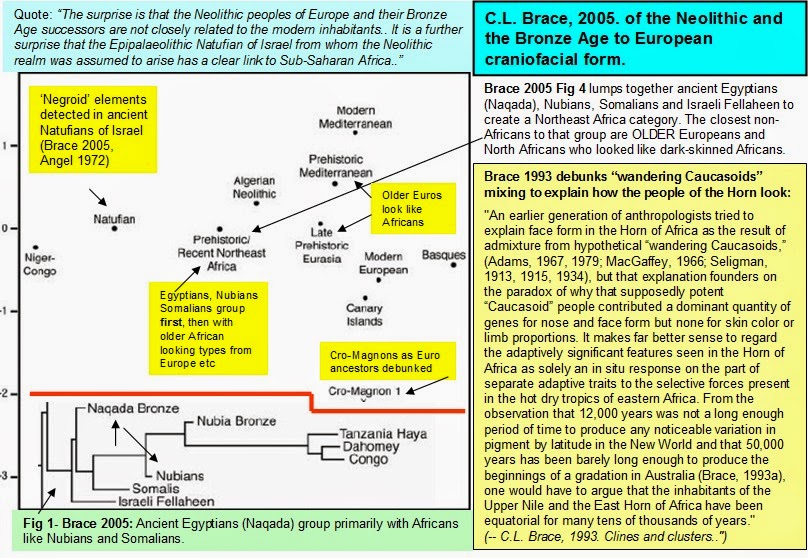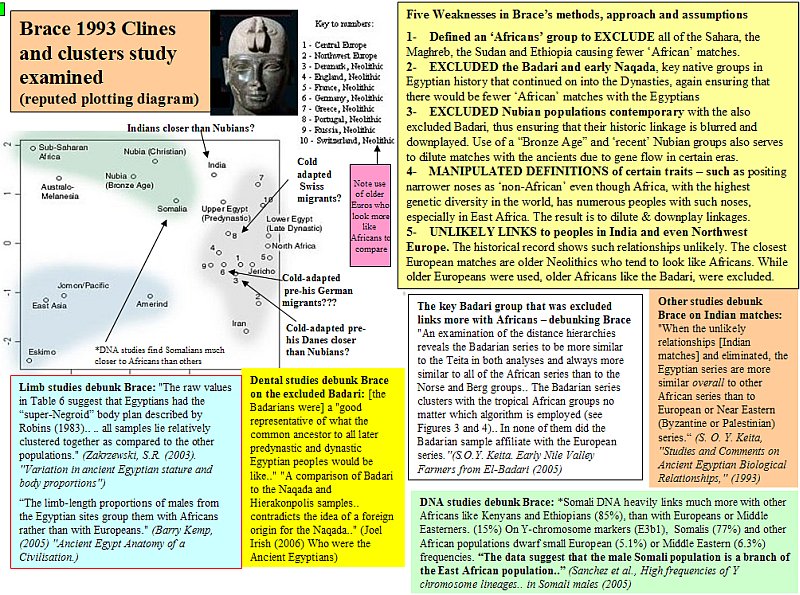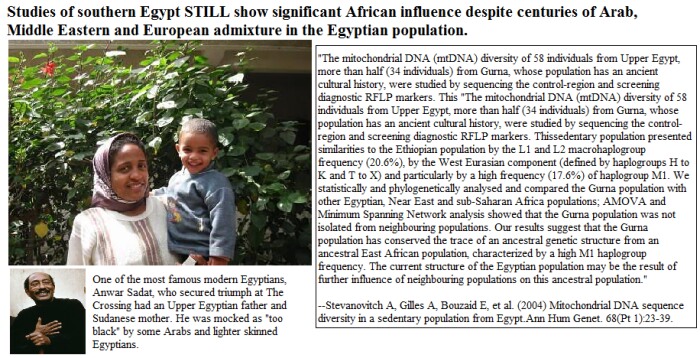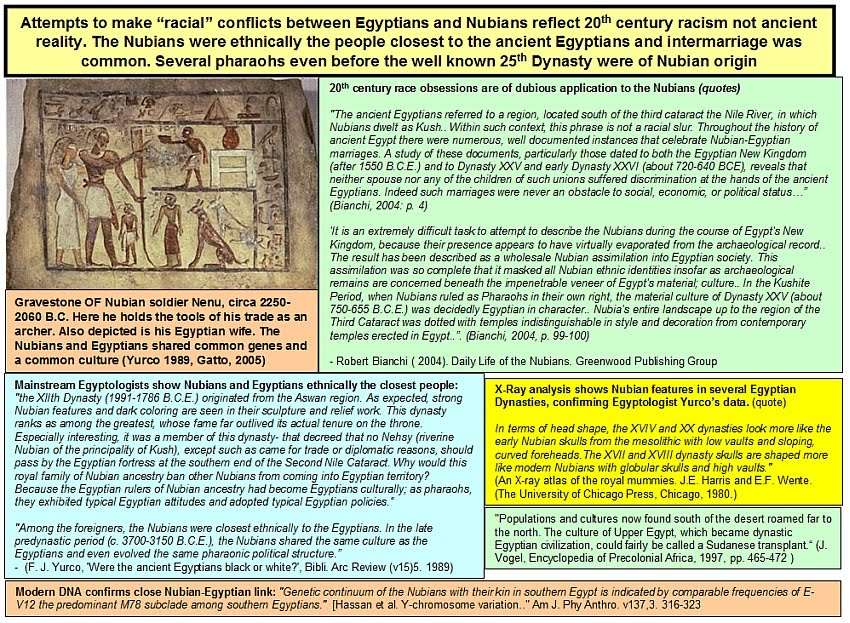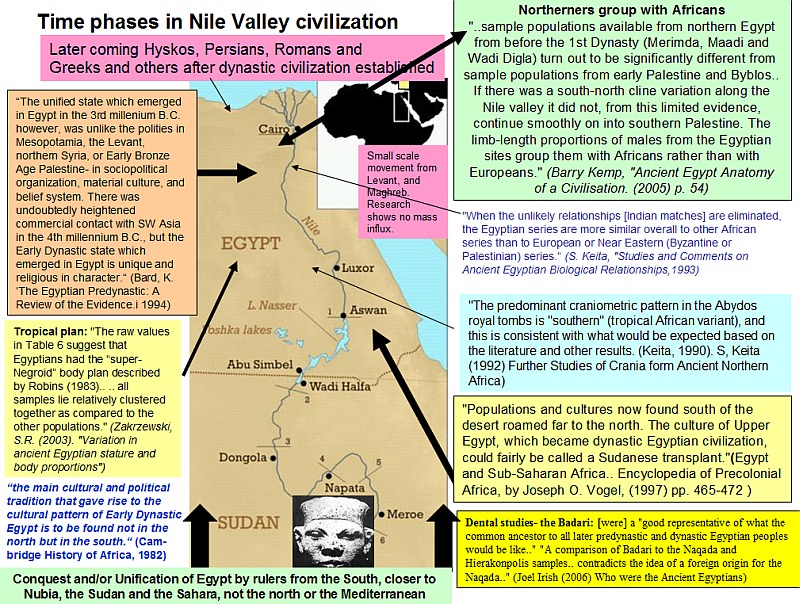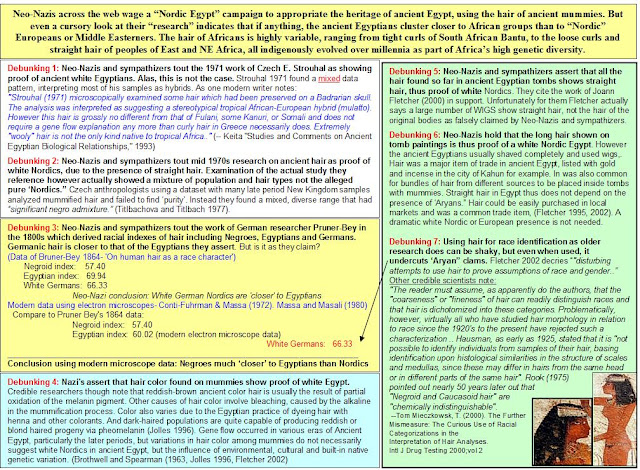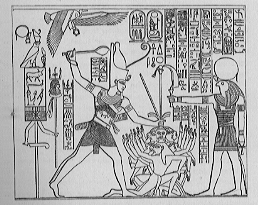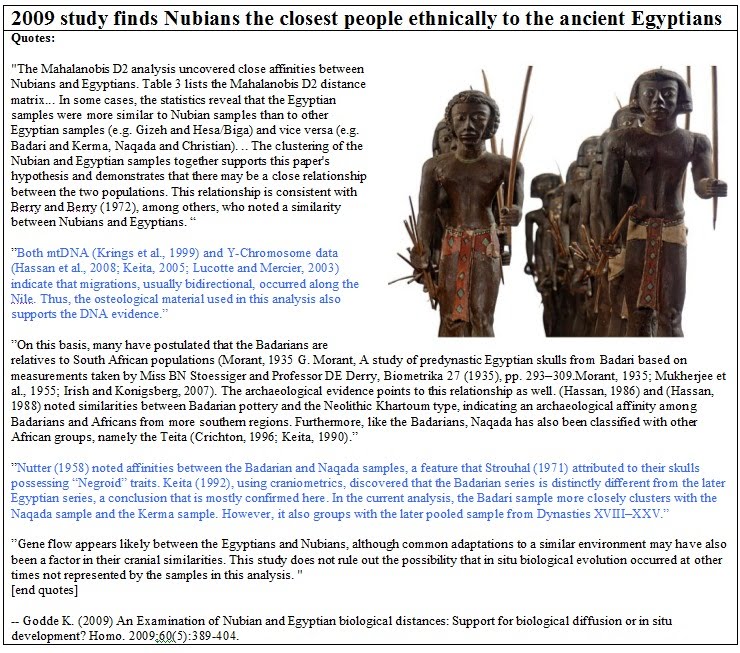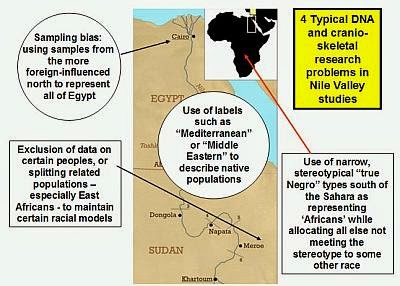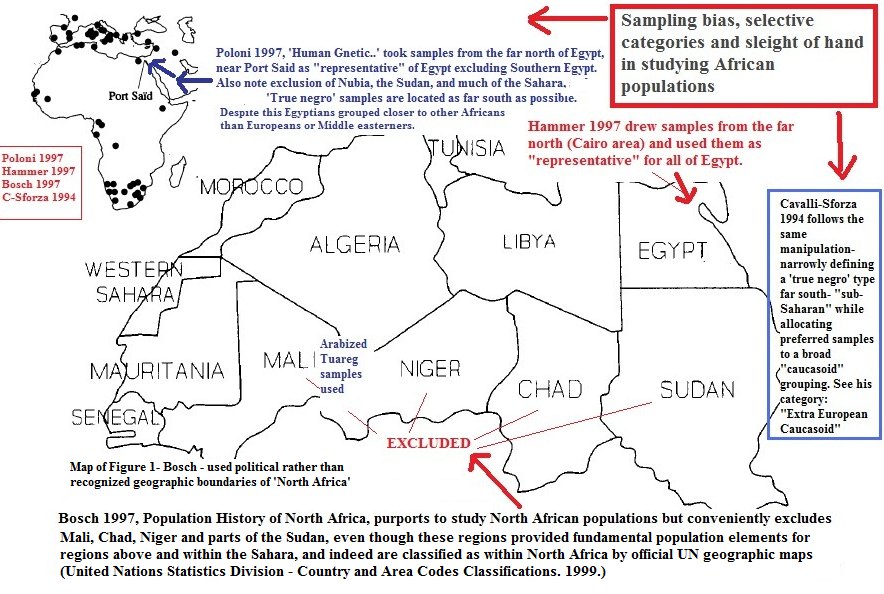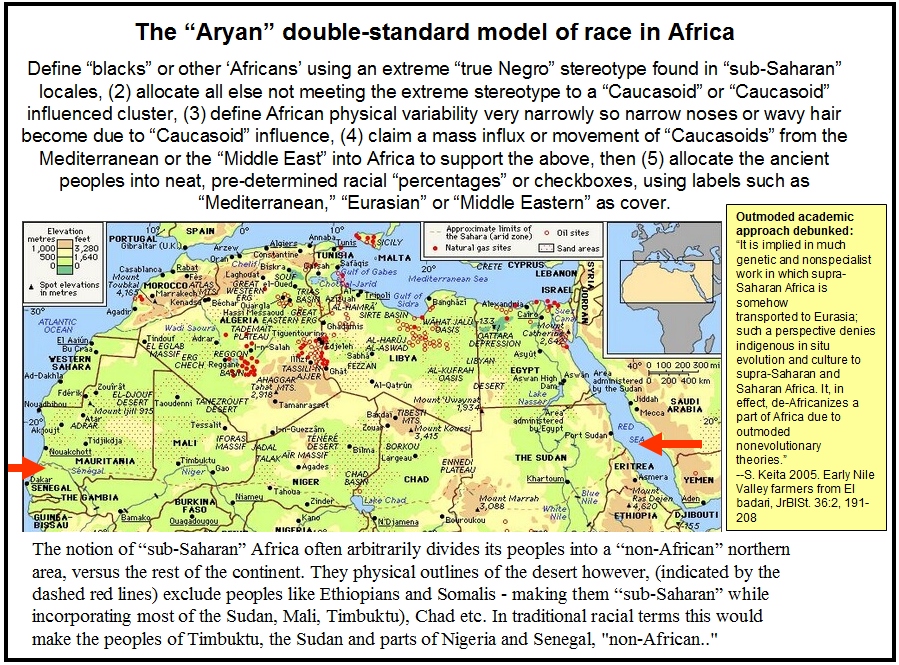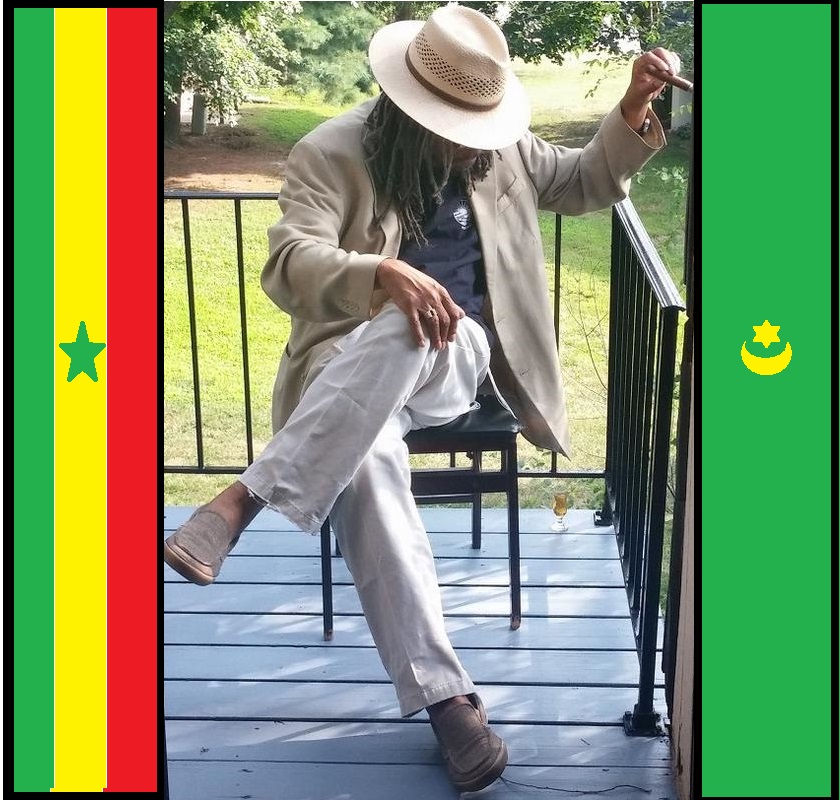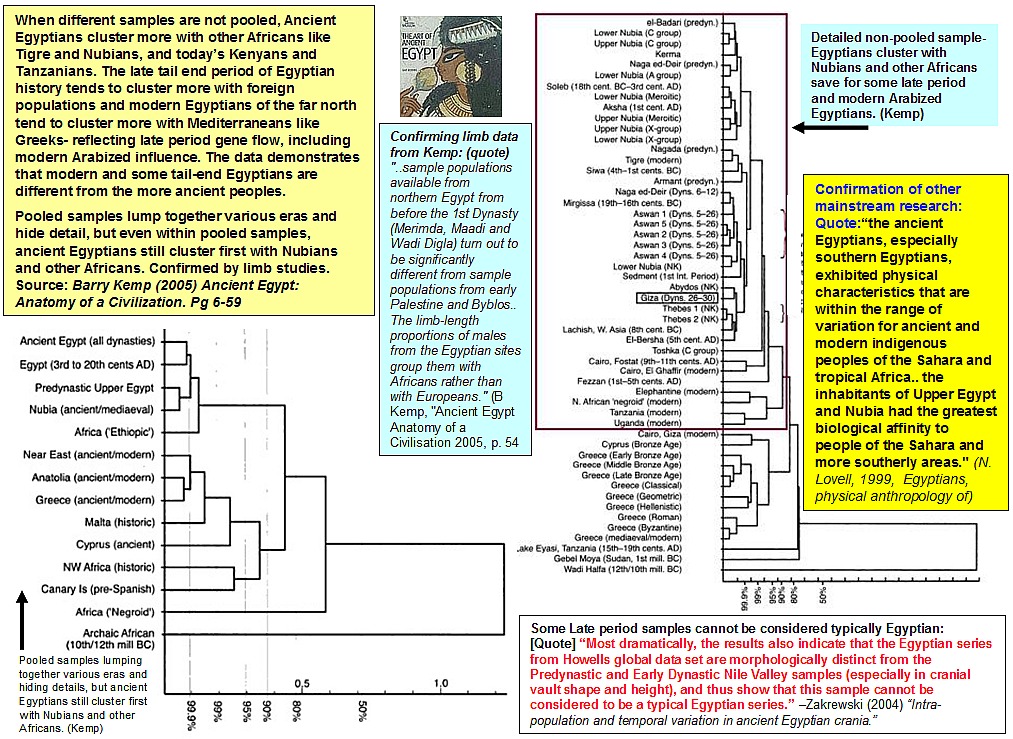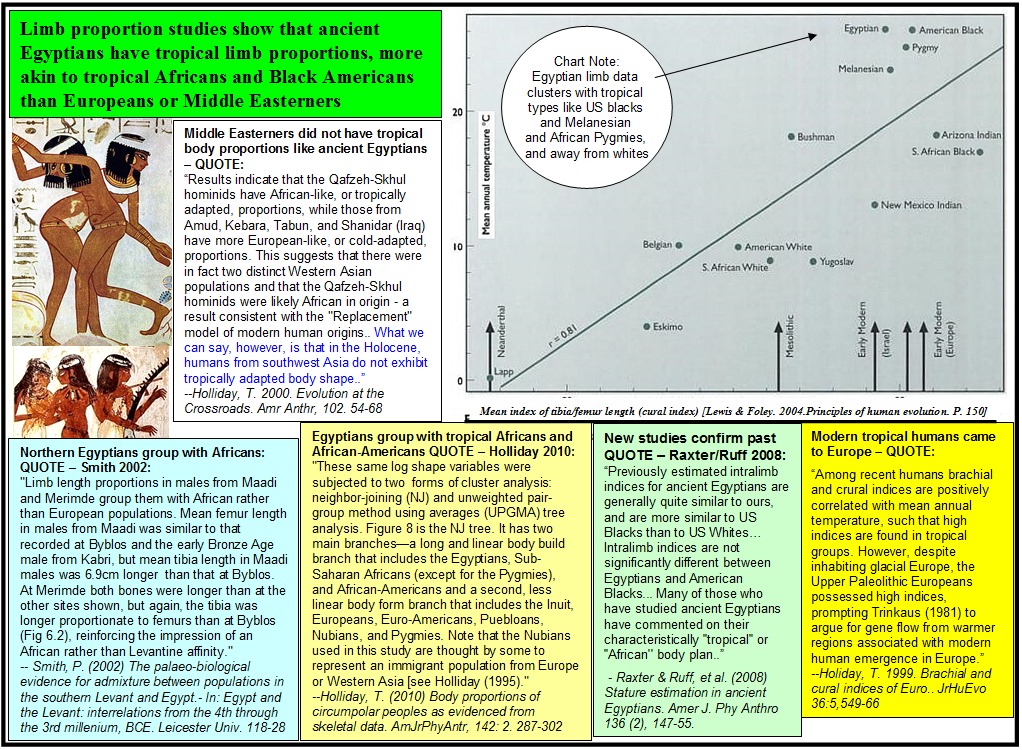Post by zarahan on Apr 1, 2010 23:52:41 GMT -5
How to use this database:
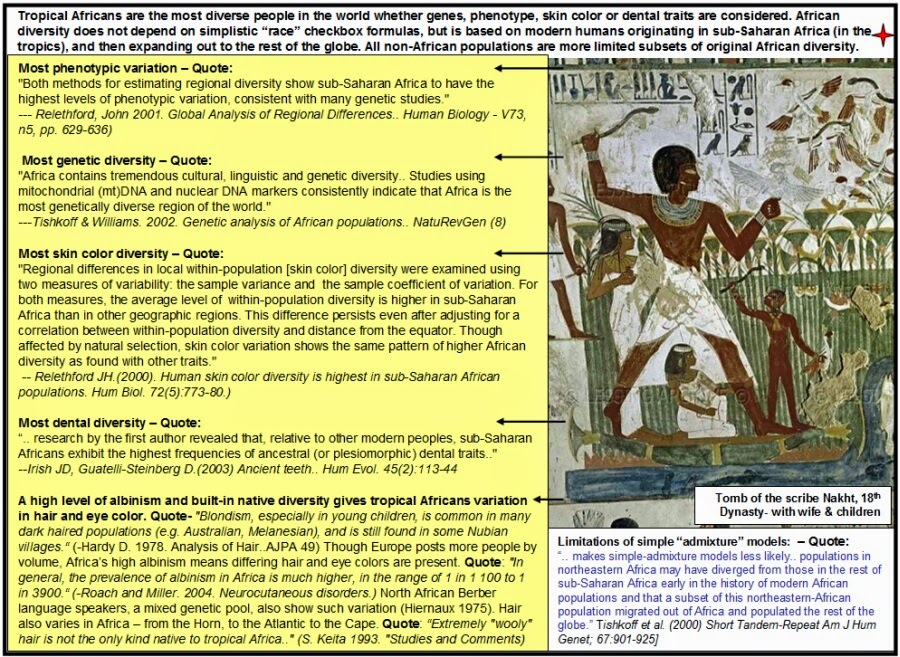
1) The ultimate purpose of the database is not "debate" as such, but to develop a deeper, wider and more accurate knowledge of African bio-cultural history and diversity, including ALL of Africa not just so-called "sub-Saharan" Africa. "Sub-Saharan" Africa- is itself an oft stereotypical concept given that African peoples do move around and are not bound by any 'apartheid' geographic barrier, and the movement of said 'barrier' southwards means that people once "sub-Saharan' become "non Sub Saharan" as the years pass. Fabled Timbuktu for example is now "non African" or "non black" since shifting sands have moved south. Ethiopia though still remains "sub-Saharan." The database seeks to present (a) a more balanced view of African diversity- biological, cultural, historical, geographical, etc, and (b) a more accurate picture of that diversity - (setting the record straight). As part of this, various chauvinisms, whether of the EUrocentric, Arabist, Afrocentric or 'Nativist' modern Egyptian varieties are given short shrift.
Note: this database relies on hard data from credible and verifiable scholarly sources- including cranial skeletal, dental, DNA archaeological, and cultural data. This is why so many citations and quotations are used. The reader is invited to verify all for themselves, and they are clearly given. Persons looking for more personal "feelings," mystical content, or support for extreme claims about no outsiders entering Africa until Greeks or Arabs showed up, or assorted absolutist "Afrocentric" statements, or dubious 'albina Caucasia' or racialist and anti-semitic "hereditarian" theories are advised to look elsewhere. Likewise folk holding to stereotypical "true negro" models re Africa and Africans will find their views and claims thoroughly debunked herein. While social constructs are an integral part of the background, and indeed the field at some level, hard specialist data, including that of credible historians, is the main thrust. The database also takes in more than Kemet or Egypt but touches heavily on the great diversity of Africa and African peoples. It is not "only" about Kemet and indeed, that diversity clearly demonstrates that Kemet is an integral part of Africa and its bio-cultural environment. Africa is the great source from which Kemet and other African civilizations sprung, not the other way around. This grassroots, "bottom up" approach guides the format.

But why, some ask? Unfortunately, a pattern of distortion and unbalanced scholarship continues to appear in the field. One recent critique of a recent ancient DNA study on ancient Egypt, exemplifies the case, with the study implying that ancient Egyptians came from the Asia, and that "sub-Saharan" African patterns in Egypt are recent due to the Islamic slave trades. Note this critique is by credible, mainstream, peer-review scholars not "random bloggers off the web." One would think that in 2022, with many in the academy having advanced degrees, backing by heavyweight universities and/or private institutions, and full tranches of grant money that there would be better, more balanced research. But this is not the case- as the critique shows: egyptsearchreloaded.proboards.com/post/18214
Many other examples of shortchanging of African diversity, exclusion of relevant data and stereotypical thinking are given herein, and the pattern is repeated in college textbooks and in the AP/Honors textbooks being taught to high school students.
2) Explanatory headings, titles or summaries are generally given in boldface, followed by a detailed quotation from a scholarly article or book on the subject. Do not mix up headings/titles with the actual quotation.
3) Read the material carefully, including titles/headings and do not simply copy it here and there without reading and understanding.
4) Many titles/headings are qualified- that is they try not to go beyond what the particular evidentiary source is saying. Make your best argument as you will, but at least have some reasonable backup- do not jump to extreme conclusions or claims that are not supported by evidence. If a heading says "some" or "in certain eras" that's exactly what it means- "some," and during those particular times. Do not leap beyond the data and claim ALL conditions, possibilities, times or scenarios are covered. "Some" is not the same as "all" - a point some "enthusiasts" seem to have missed. Despite this warning, a number of said "enthusiasts" have taken to stretching the data in misleading ways, including attempting to shoehorn "Dravidians" from India into Kemet or Nubian culture, or having ancient "Niger-Congo" migrants "fleeing" from Egypt to West Africa to bring civilization when Persians showed up on the Nile. Such stretched "diffusionist" interpretations are not warranted from the data, nor "endorsed" anywhere here. If any are attempting to conjure some sort of "Afro" strawman out of the data here, you have already failed.
5) The data works as a FLEXIBLE COMBINED ARMS package - multiple lines of evidence: Skeletal, cranial, dental, DNA, cultural, religious, geographical, archaeological and others. These multiple lines support one another. Do not rely on one thing only. The overall base is an anvil, upon which all these other hammers strike. In this business knowledge does not stay static. Be ready to adjust your arguments or thinking where warranted by confirming data. Be ready to adjust, AND wield the hammers, while holding the core principles of the anvil (African diversity) firm.
6) ALWAYS KEEP IN MIND THE CENTRAL POINT OF THE DIVERSITY OF AFRICANS- VIGOROUSLY REJECT AND ATTACK ALL STEREOTYPICAL CONSTRUCTS. African diversity is based on hard data from multiple lines. Fiercely reject any "true negro" insinuation and construct. Reject any attempts to limit African culture and/or movement to some sort of artificial "sub-Saharan" stereotype. Africans can move around and have from Asia, to Europe and beyond. They are not "confined" to "sub-Saharan" locales. They can develop writing, build cities, create empires without needing any "wandering Caucasoids." And maintain the view of tropical Africans- they extend from southern Africa to southern Egypt. "Tropical" does not just mean "jungle" or "savanna." And Africans have the greatest phenotypic and genetic diversity- they can have narrow noses, light skin, loose hair, etc etc- as part of BUILT-IN native variety, without needing any "race mix" to explain why. Hard data confirms this diversity. Always insist on it.

7. Social constructs such as the European-American "one-drop" rule are a reality for many, but are a secondary consideration. Old questions such as "whether the Egyptians are black" are not foremost. The label "black" is a social construct- and certainly using racial social constructs developed by Europeans and Americans, Ancient Egyptians can be consistently and reasonably be labeled as "black." On this agree specialist Egyptologists (Tyson-Smith 2001) along with others, and balanced analyses such as that of archaeologists and other scholars like Dr. Marie Gatto, (University of Leicester), or Dr. Sally-Ann Ashton(Department of Antiquities at the Fitzwilliam Museum, University of Cambridge), further confirms the case of data. But such labels are peripheral to the PRIMARY consideration- the African character and foundations of not only Kemet but all the classical Nile Valley Civilizations. Hence "social construct blackness" is not at the top of the list of things to focus on. This database relies on hard data- skeletal, DNA, cranial, cultural, dental etc that demonstrates that African character and foundation. It does not revolve around social construct labels. A focus on labels is often used to divert attention from the hard data making the case. While labels are a valid and important consideration for discussion (especially since the enemies of a balanced African bio-cultural narrative keep on using them), they are a secondary element compared to the solid body of hard evidence and data herein. Do not let the labeling game overshadow the hard evidence. This is precisely what opponents often want, so they can sidetrack and divert discussion by invoking "politics." You can contradict opponents with their own labeling game but remember, data makes the case.
8) Finally, maintaining a balanced view of African bio-cultural history and diversity, at times will require (a) unapologetic confrontation (see for example) and aggressive defense on behalf of African peoples, and (b) relentless exposure of Eurocentric and Arabist/'Nativist' hypocrisy. Recognize that at times your activities will not be so much to persuade intellectually dishonest opponents, propagandists or racists of the hard or "soft" variety- it will be to hit them hard.
See for example a thorough debunking of assorted Arabists, Antisemite and racist mentalities below:
egyptsearchreloaded.proboards.com/thread/3513/blast-past-racists-arabists-antisemites
Much of this info drives an extremely sharp and threatening blade into the heart of cherished supremacist narratives, myths and constructs. This includes claims advanced by so-called 'nativists' who keep denying the African background of Kemet, including its peopling by indigenous tropical Africans- as if ancient Egyptians spontaneously sprang up out of the Nile- remnants of the crocodile gods and frog goddesses who attended upon Hapi, deity of the Nile. Whatever their guise, drive home data harpoons vigorously, as the need arises. At other times you will meet more reasonable people who will hold honest dialog, and can be persuaded, or at least joined in a respectful exchange of views, using not emotional appeals but clear logic and data. With these genuine people a less aggressive tone can be taken, and to be sure, we all can agree to disagree at the end of the day. This is fine. But be aware that distorting, hypocritical opponents will appear aplenty. Load for bear, and shoot accordingly.
x
links- site excample
www.nairaland.com/2335643/how-africa-break-lose-western
----------------------------------------------------------------------------------------------------------------------
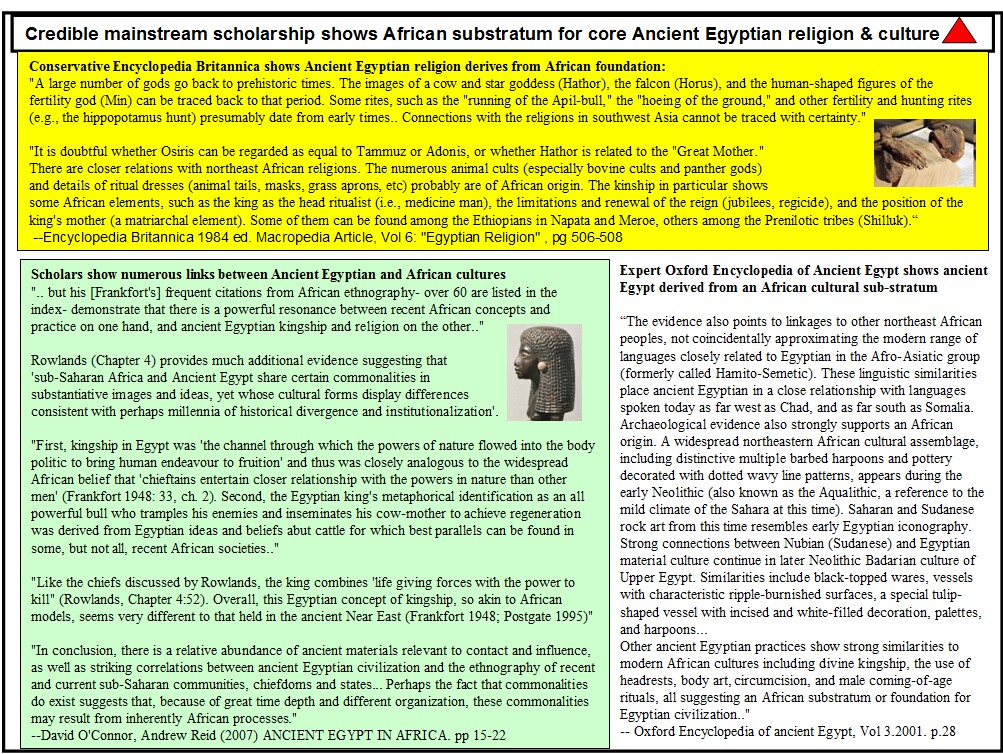
Recent studies find the ancient Egyptians had a tropical body plan like sub-Saharan 'black' Africans and were not cold-adapted like European type populations. Tropical body plans also indicate darker-skin.
QUOTE:
"The raw values in Table 6 suggest that Egyptians had the "super-Negroid" body plan described by Robins (1983).. This pattern is supported by Figure 7 (a plot of population mean femoral and tibial lengths; data from Ruff, 1994), which indicates that the Egyptians generally have tropical body plans. Of the Egyptian samples, only the Badarian and Early Dynastic period populations have shorter tibiae than predicted from femoral length. Despite these differences, all samples lie relatively clustered together as compared to the other populations." (Zakrzewski, S.R. (2003). "Variation in ancient Egyptian stature and body proportions". American Journal of Physical Anthropology 121 (3): 219-229.
a 2008 Study puts the ancient Egyptians closer to US Blacks than whites:
Quotes:
"Intralimb (crural and brachial) indices are significantly higher in ancient Egyptians than in American Whites (except crural index among females), i.e., Egyptians have relatively longer distal segments (Table 4). Intralimb indices are not significantly different between Egyptians and American Blacks... Many of those who have studied ancient Egyptians have commented on their characteristically ''tropical'' or ''African'' body plan (Warren, 1897; Masali, 1972; Robins, 1983; Robins and Shute, 1983, 1984, 1986; Zakrzewski, 2003). Egyptians also fall within the range of modern African populations (Ruff and Walker, 1993), but close to the upper limit of modern Europeans as well, at least for the crural index (brachial indices are definitely more ''African'').. In terms of femoral and tibial length to total skeletal height proportions, we found that ancient Egyptians are significantly different from US Blacks, although still closer to Blacks than to Whites.
Comparisons of linear body proportions of Old Kingdom and non-Old Kingdom period individuals, and workers and high officials in our sample found no statistically significant differences among them. Zakrzewski (2003) also found little evidence for differences in linear body proportions of Egyptians over a wider temporal range. In general, recent studies of skeletal variation among ancient Egyptians support scenarios of biological continuity through time. Irish (2006) analyzed quantitative and qualitative dental traits of 996 Egyptians from Neolithic through Roman periods, reporting the presence of a few outliers but concluding that the dental samples appear to be largely homogeneous and that the affinities observed indicate overall biological uniformity and continuity from Predynastic through Dynastic and Postdynastic periods.
Zakrzewski (2007) provided a comprehensive summary of previous Egyptian craniometric studies and examined Egyptian crania from six time periods. She found that the earlier samples were relatively more homogeneous in comparison to the later groups. However, overall results indicated genetic continuity over the Egyptian Predynastic and Early Dynastic periods, albeit with a high level of genetic diversity within the population, suggesting an indigenous process of state formation. She also concluded that while the biological patterning of the Egyptian population varied across time, no consistent temporal or spatial trends are apparent. Thus, the stature estimation formulae developed here may be broadly applicable to all ancient Egyptian populations.."
("Stature estimation in ancient Egyptians: A new technique based on anatomical reconstruction of stature." Michelle H. Raxter, Christopher B. Ruff, Ayman Azab, Moushira Erfan, Muhammad Soliman, Aly El-Sawaf, (Am J Phys Anthropol. 2008, Jun;136(2):147-55
Older limb studies find the same: [/b]
"In this regard it is interesting to note that limb proportions of Predynastic Naqada people in Upper Egypt are reported to be "Super-Negroid," meaning that the distal segments are elongated in the fashion of tropical Africans.....skin color intensification and distal limb elongation are apparent wherever people have been long-term residents of the tropics." (C.L. Brace, 1993. Clines and clusters..")
"An attempt has been made to estimate male and female Egyptian stature from long bone length using Trotter & Gleser negro stature formulae, previous work by the authors having shown that these rather than white formulae give more consistent results with male dynastic material... When consistency has been achieved in this way, predynastic proportions are founded to be such that distal segments of the limbs are even longer in relation to the proximal segments than they are in modern negroes. Such proportions are termed "super-negroid"...
Robins (1983) and Robins & Shute (1983) have shown that more consistent results are obtained from ancient Egyptian male skeletons if Trotter & Gleser formulae for negro are used, rather than those for whites which have always been applied in the past. .. their physical proportions were more like modern negroes than those of modern whites, with limbs that were relatively long compared with the trunk, and distal segments that were long compared with the proximal segments. If ancient Egyptian males had what may be termed negroid proportions, it seems reasonable that females did likewise."
(Robins G, Shute CCD. 1986. Predynastic Egyptian stature and physical proportions. Hum Evol 1:313-324. Ruff CB. 1994.)
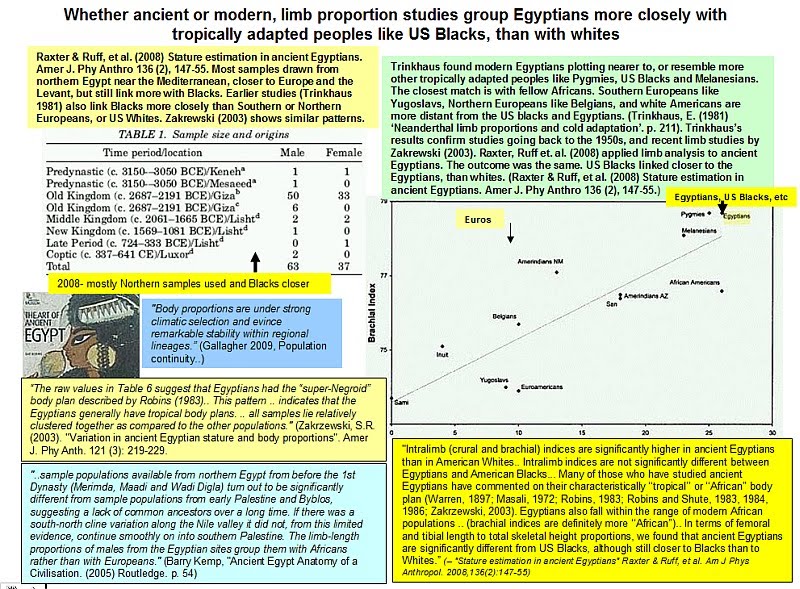
Modern anthropology shows that the ancient Egyptians are well within the range of tropical Africa, contradicting older research in the 1990s that sought to deny any relationship. The anthropologist below, Nancy Lovell was recommended by Mary lefkowitz in Black Athena Revisted.
"There is now a sufficient body of evidence from modern studies of skeletal remains to indicate that the ancient Egyptians, especially southern Egyptians, exhibited physical characteristics that are within the range of variation for ancient and modern indigenous peoples of the Sahara and tropical Africa.. In general, the inhabitants of Upper Egypt and Nubia had the greatest biological affinity to people of the Sahara and more southerly areas." (Nancy C. Lovell, " Egyptians, physical anthropology of," in Encyclopedia of the Archaeology of Ancient Egypt, ed. Kathryn A. Bard and Steven Blake Shubert, ( London and New York: Routledge, 1999) pp 328-332)
The ancient Badarians were quite representative of ancient Egyptians as a whole and showed clear links with tropical Africans to the south. They have been sometimes excluded in studies of the ancient Egyptian population, which shows continuity in its history, not mass influxes of foreigners until the late periods.
Quotes:
"As a result of their facial prognathism, the Badarian sample has been described as forming a morphological cluster with Nubian, Tigrean, and other southern (or "Negroid") groups (Morant, 1935, 1937; Mukherjee et al., 1955; Nutter, 1958, Strouhal, 1971; Angel, 1972; Keita, 1990). Cranial nonmetric trait studies have found this group to be similar to other Egyptians, including much later material (Berry and Berry, 1967, 1972), but also to be significantly different from LPD material (Berry et al., 1967). Similarly, the study of dental nonmetric traits has suggested that the Badarian population is at the centroid of Egyptian dental samples (Irish, 2006), thereby suggesting similarity and hence continuity across Egyptian time periods. From the central location of the Badarian samples in Figure 2, the current study finds the Badarian to be relatively morphologically close to the centroid of all the Egyptian samples. The Badarian have been shown to exhibit
greatest morphological similarity with the temporally successive EPD (Table 5). Finally, the biological distinctiveness
of the Badarian from other Egyptian samples has also been demonstrated (Tables 6 and 7).
These results suggest that the EDyn do form a distinct morphological pattern. Their overlap with other Egyptian samples (in PC space, Fig. 2) suggests that although their morphology is distinctive, the pattern does overlap with the other time periods. These results therefore do not support the Petrie concept of a \Dynastic race" (Petrie, 1939; Derry, 1956). Instead, the results suggest that the Egyptian state was not the product of mass movement of populations into the Egyptian Nile region, but rather that it was the result of primarily indigenous development combined with prolonged small-scale migration, potentially from trade, military, or other contacts.
This evidence suggests that the process of state formation itself may have been mainly an indigenous process, but that it may have occurred in association with in-migration to the Abydos region of the Nile Valley. This potential in-migration may have occurred particularly during the EDyn and OK. A possible explanation is that the Egyptian state formed through increasing control of trade and raw materials, or due to military actions, potentially associated with the use of the Nile Valley as a corridor for prolonged small scale movements through the desert environment.
(Sonia R. Zakrzewski. (2007). Population Continuity or Population Change: Formation of the Ancient Egyptian State. AMERICAN JOURNAL OF PHYSICAL ANTHROPOLOGY 132:501-509)
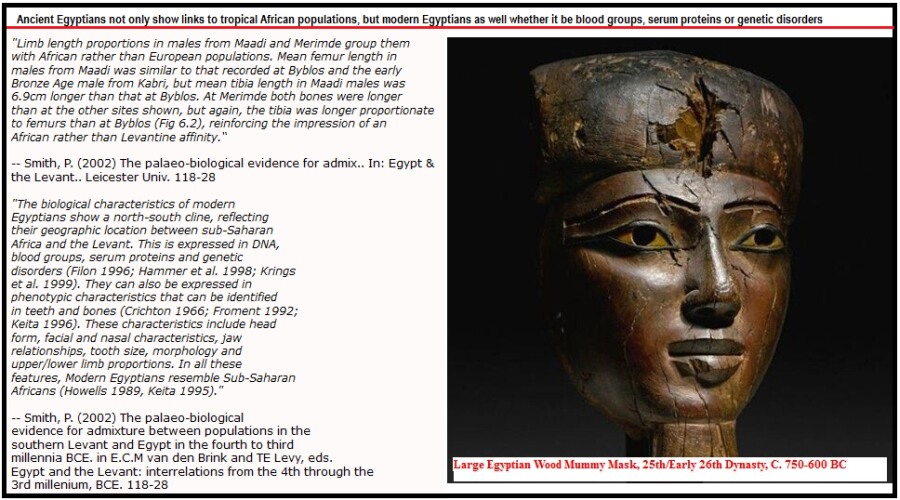
Ancient Egyptians most related to other Africans and are part of a Nilotic continuity rather than something Mediterranean or Middle Eastern
"Certainly there was some foreign admixture [in Egypt], but basically a homogeneous African population had lived in the Nile Valley from ancient to modern times... [the] Badarian people, who developed the earliest Predynastic Egyptian culture, already exhibited the mix of North African and Sub-Saharan physical traits that have typified Egyptians ever since (Hassan 1985; Yurco 1989; Trigger 1978; Keita 1990.. et al.,)... The peoples of Egypt, the Sudan, and much of East African Ethiopia and Somalia are now generally regarded as a Nilotic continuity, with widely ranging physical features (complexions light to dark, various hair and craniofacial types) but with powerful common cultural traits, including cattle pastoralist traditions.." (Frank Yurco, "An Egyptological Review," 1996 -in Mary R. Lefkowitz and Guy MacLean Rogers, Black Athena Revisited, 1996, The University of North Carolina Press, p. 62-100)
African peoples are the most diverse in the world whether analyzed by DNA or skeletal or cranial methods. Attempts to deny this are rooted in racism and error. African people, particularly SUB-SAHARAN Africans, vary the most in how they look, more so than any other population in the world.
"Estimates of genetic diversity in major geographic regions are frequently made by pooling all individuals into regional aggregates. This method can potentially bias results if there are differences in population substructure within regions, since increased variation among local populations could inflate regional diversity. A preferred method of estimating regional diversity is to compute the mean diversity within local populations. Both methods are applied to a global sample of craniometric data consisting of 57 measurements taken on 1734 crania from 18 local populations in six geographic regions: sub-Saharan Africa, Europe, East Asia, Australasia, Polynesia, and the Americas. Each region is represented by three local populations.
Both methods for estimating regional diversity show sub-Saharan Africa to have the highest levels of phenotypic variation, consistent with many genetic studies."
(Relethford, John "Global Analysis of Regional Differences in Craniometric Diversity and Population Substructure". Human Biology - Volume 73, Number 5, October 2001, pp. 629-636)
#
"In addition, craniometric variation also shows agreement with genetic data in showing highest levels of diversity in sub-Saharan Africa than in other geographic regions (Relethford and Harpending, 1994). Further, there is a clear decline in levels of craniometric variation as geographic distance from East Africa increases (Manica et al., 2007; von Cramon-Taubadel and Lycett, 2008; Betti et al., 2009)."
-- John H. Relethford* (2010). Population-Specific Deviations of Global Human Craniometric Variation From a Neutral Model. AMERICAN JOURNAL OF PHYSICAL ANTHROPOLOGY 2010
"The living peoples of the African continent are diverse in facial characteristics, stature, skin color, hair form, genetics, and other characteristics. No one set of characteristics is more African than another. Variability is also found in "sub-Saharan" Africa, to which the word "Africa" is sometimes erroneously restricted. There is a problem with definitions. Sometimes Africa is defined using cultural factors, like language, that exclude developments that clearly arose in Africa. For example, sometimes even the Horn of Africa (Somalia, Ethiopia, Eritrea) is excluded because of geography and language and the fact that some of its peoples have narrow noses and faces.
However, the Horn is at the same latitude as Nigeria, and its languages are African. The latitude of 15 degree passes through Timbuktu, surely in "sub-Saharan Africa," as well as Khartoum in Sudan; both are north of the Horn. Another false idea is that supra-Saharan and Saharan Africa were peopled after the emergence of "Europeans" or Near Easterners by populations coming from outside Africa. Hence, the ancient Egyptians in some writings have been de-Africanized. These ideas, which limit the definition of Africa and Africans, are rooted in racism and earlier, erroneous "scientific" approaches." (S. Keita, "The Diversity of Indigenous Africans," in Egypt in Africa, Theodore Clenko, Editor (1996), pp. 104-105. [10])
Modern DNA studies find even though some African peoples look different, they are genetically related through the PN2 transition clade of the Y-chromosone. Haplogroup E links numerous peoples together even though they don't look exactly the same.
"But the Y-chromosome clade defined by the PN2 transition (PN2/M35, PN2/M2) shatters the boundaries of phenotypically defined races and true breeding populations across a great geographical expanse. African peoples with a range of skin colors, hair forms and physiognomies have substantial percentages of males whose Y chromosomes form closely related clades with each other, but not with others who are phenotypically similar. The individuals in the morphologically or geographically defined 'races' are not characterized by 'private' distinct lineages restricted to each of them." (S O Y Keita, R A Kittles, et al. "Conceptualizing human variation," Nature Genetics 36, S17 - S20 (2004)

"Recall that the Horn-Nile Valley crania show, as a group, the largest overlap with other regions. A review of the recent literature indicates that there are male lineage ties between African peoples who have been traditionally labeled as being ''racially'' different, with ''racially'' implying an ontologically deep divide. The PN2 transition, a Y chromosome marker, defines a lineage (within the YAPþ derived haplogroup E or III) that emerged in Africa probably before the last glacial maximum, but after the migration of modern humans from Africa (see Semino et al., 2004). This mutation forms a clade that has two daughter subclades (defined by the biallelic markers M35/215 (or 215/M35) and M2) that unites numerous phenotypically variant African populations from the supra-Saharan, Saharan, and sub-Saharan regions.."
(S.O.Y Keita. Exploring northeast African metric craniofacial variation at the individual level: A comparative study using principal component analysis. Am. J. Hum. Biol. 16:679-689, 2004.)
keita2004neanalysis.htm
"Africa contains tremendous cultural, linguistic and genetic diversity, and has more than 2,000 distinct ethnic groups and languages.. Studies using mitochondrial (mt)DNA and nuclear DNA markers consistently indicate that Africa is the most genetically diverse region of the world." (Tishkoff SA, Williams SM., Genetic analysis of African populations: human evolution and complex disease. Nature Reviews Genetics. 2002 Aug (8):611-21.)
DNA of some modern Egyptians found a genetic ancestral heritage to East Africa:
"The mitochondrial DNA (mtDNA) diversity of 58 individuals from Upper Egypt, more than half (34 individuals) from Gurna, whose population has an ancient cultural history, were studied by sequencing the control-region and screening diagnostic RFLP markers. This sedentary population presented similarities to the Ethiopian population by the L1 and L2 macrohaplogroup frequency (20.6%), by the West Eurasian component (defined by haplogroups H to K and T to X) and particularly by a high frequency (17.6%) of haplogroup M1. We statistically and phylogenetically analysed and compared the Gurna population with other Egyptian, Near East and sub-Saharan Africa populations; AMOVA and Minimum Spanning Network analysis showed that the Gurna population was not isolated from neighbouring populations. Our results suggest that the Gurna population has conserved the trace of an ancestral genetic structure from an ancestral East African population, characterized by a high M1 haplogroup frequency. The current structure of the Egyptian population may be the result of further influence of neighbouring populations on this ancestral population."
(Stevanovitch A, Gilles A, Bouzaid E, et al. (2004) Mitochondrial DNA sequence diversity in a sedentary population from Egypt.Ann Hum Genet. 68(Pt 1):23-39.)
Tishkoff et al on Africa having the most genetic diversity:
"Africa contains tremendous cultural, linguistic and genetic diversity, and has more than 2,000 distinct ethnic groups and languages (see online link to Ethnologue). Studies using mitochondrial (mt)DNA and nuclear DNA markers consistently indicate that Africa is the most genetically diverse region of the world(TABLE 1).However,most studies report only a few markers in divergent African populations, which makes it difficult to draw general conclusions about the levels and patterns of genetic diversity in these populations (FIG. 1). Because genetic studies have been biased towards more economically developed African countries that have key research or medical centres, populations from more underdeveloped or politically unstable regions of Africa remain undersampled (FIG. 1). Historically, human population genetic studies have relied on one or two African populations as being representative of African diversity, but recent studies show extensive genetic variation among even geographically close African populations, which indicates that there is not a single 'representative' African population."
-- Tishkoff NATURE REVIEWS | GENETICS VOLUME 3 | AUGUST 2002
Mainstream scholars note that genetic studies often used a narrow range of stereotyped samples to represent 'Africans', even splitting off peoples of the Horn of Africa as some separate "non african" type or race.
"Genetic studies that attempt to recover the biological history of the species have generally found that there is a split between their restricted African samples and "the rest of the world." These approaches conceptualize human population history as a series of bifurcations with each node being relatively uniform. The "Africans" usually used are either the short statured Aka or Mbuti, Khoisan speakers, or West African stereotypes, in keeping with a socially, not scientifically constructed concept of African. Studies using individuals as the unit of analysis evince a different pattern. A select subset of Africans called the "group of 49" forms a unit versus the rest of humankind. However the latter individuals ("rest of humankind") also includes non-East African sub-Saharans. Hence there is no "racial" split. As has been stated, the idea that human variation can be described as being structured by subspecies(races) that are treated as lineages is fundamentally false. In actuality, also, although averages are used, the gene studies usually give us histories that are not necessarily the same as population histories."
(Writing African History Chapter 4, Physical Anthropology and African History, Shomarka Keita University of Rochester Press p.134
Continent wide African DNA linkages
"The most extensive pan-African haplotype (16189 16192 16223 16278 16294 16309 16390) is in the L2a1 haplogroup. This sequence is observed in West Africa among the Malinke, Wolof, and others; in North Africa among the Maure, Hausa, Fulbe, and others; in Central Africa among the Bamileke, Fali, and others; in South Africa among the Khoisan family including the Khwe and Bantu speakers; and in East Africa among the Kikuyu. Closely related variants are observed among the Tuareg in North and West Africa and among the East African Dinka and Somali."
(-- Bert Ely , Jamie Lee Wilson , Fatimah Jackson and Bruce A Jackson. (2006). African-American mitochondrial DNAs often match mtDNAs found in multiple African ethnic groups. BMC Biology 2006, 4:34)
"It is of interest that the M35 and M2 lineages are united by a mutation - the PN2 transition. This PN2 defined clade originated in East Africa, where various populations have a notable frequency of its underived state. This would suggest that an ancient population in East Africa, or more correctly its males, form the basis of the ancestors of all African upper Paleolithic populations - and their subsequent descendants in the present day."
(--Bengston, John D. (ed.), In Hot Pursuit of Language in Prehistory: Essays in the four fields of anthropology. 2008. John Benjamins Publishing: pp. 3-16)
Somalis link much more heavily with African populations such as those in Kenya and Ethiopia than Middle Eastern or European ones according to DNA evidence. Eurasian genes only accounted for about 15% of the mix among Somalis, typically associated with recent Arab influence. On such key common DNA markers as E3b1, Europeans only weighed in at 5%, and Middle Easterners at approximately 6%. The overwhelming link of Somalis- over 85% of the total is with Africans. Kenya and Ethiopia are located in "sub-Saharan" Africa.
"The high frequency (77.6%) of haplogroup E3b1 was characteristic of male Somalis. The frequency of E3b1 was significantly lower in Ethiopian Oromos (35.9%), Ethiopian Amharas (22.9%), Egyptians (20.0%), Sudanese (17.5%), Kenyans (15.1%),10 Iraqis (6.3%), Northern Africans (6.1%), Southern Europeans (0.5-5.1%) and sub-Saharan populations." (Sanchez et al.,(2005) High frequencies of Y chromosome lineages characterized by E3b1, DYS19-11, DYS392-12 in Somali males, Eu J of Hum Genet (2005) 13, 856-866)[/b][/b][/i]
------------------------------------------------------------------
Simplistic "race percentage" models are dubious in Africa which has the highest genetic diversity in the world. That diversity proceeded from deeper sub-Saharan Africa, to East and N.E. Africa, then to the rest of the globe. All other populations, including Europeans and "Middle easterners" carry this diversity which was built into Africa to begin with. Africans thus don't need any "race mix" to look different. Their diversity is built-in and supplied the whole globe. Any returnees or "backflow" to Africa looked like Africans. (Brace 2005, Hanihara 1996, Holliday 2003).
" These studies suggest a recent and primary subdivision between African and non-African populations, high levels of divergence among African populations, and a recent shared common ancestry of non-African populations, from a population originating in Africa. The intermediate position, between African and non-African populations, that the Ethiopian Jews and Somalis occupy in the PCA plot also has been observed in other genetic studies (Ritte et al. 1993; Passarino et al. 1998) and could be due either to shared common ancestry or to recent gene flow. The fact that the Ethiopians and Somalis have a subset of the sub-Saharan African haplotype diversity and that the non-African populations have a subset of the diversity present in Ethiopians and Somalis makes simple-admixture models less likely; rather, these observations support the hypothesis proposed by other nuclear-genetic studies (Tishkoff et al. 1996a, 1998a, 1998b; Kidd et al. 1998) that populations in northeastern Africa may have diverged from those in the rest of sub-Saharan Africa early in the history of modern African populations and that a subset of this northeastern-African population migrated out of Africa and populated the rest of the globe. These conclusions are supported by recent mtDNA analysis (Quintana-Murci et al. 1999)."
[Tishkoff et al. (2000) Short Tandem-Repeat Polymorphism/Alu Haplotype Variation at the PLAT Locus: Implications for Modern Human Origins. Am J Hum Genet; 67:901-925]
Data on Ethiopian peoples like the Oromo are underreported even though they make up the largest group percentage wise in the Ethiopian population, (50%) and are often pooled with others, hiding and obscuring their overall contribution to the Ethiopian gene pool.
"This difference, not revealed in the study by Passarino et al. (1998), in which the Oromo were underrepresented, might reflect distinct population histories."
(--Semino, et al. (2002). Ethiopians and Khoisan Share the Deepest Clades of the Human Y..")
"These data, together with those reported elsewhere (Ritte et al. 1993a, 1993b; Hammer et al. 2000) suggest that the Ethiopian Jews acquired their religion without substantial genetic admixture from Middle Eastern peoples and that they can be considered an ethnic group with essentially a continental African genetic composition." (Cruciani, et. al Am J Hum Genet. 2002 May; 70(5): 1197-1214. "A Back Migration from Asia to Sub-Saharan Africa Is Supported by High-Resolution Analysis of Human Y-Chromosome Haplotypes)
"An earlier generation of anthropologists tried to explain face form in the Horn of Africa as the result of admixture from hypothetical “wandering Caucasoids,”.. but that explanation founders on the paradox of why that supposedly potent “Caucasoid” people contributed a dominant quantity of genes for nose and face form but none for skin color or limb proportions." --CL Brace, 1993
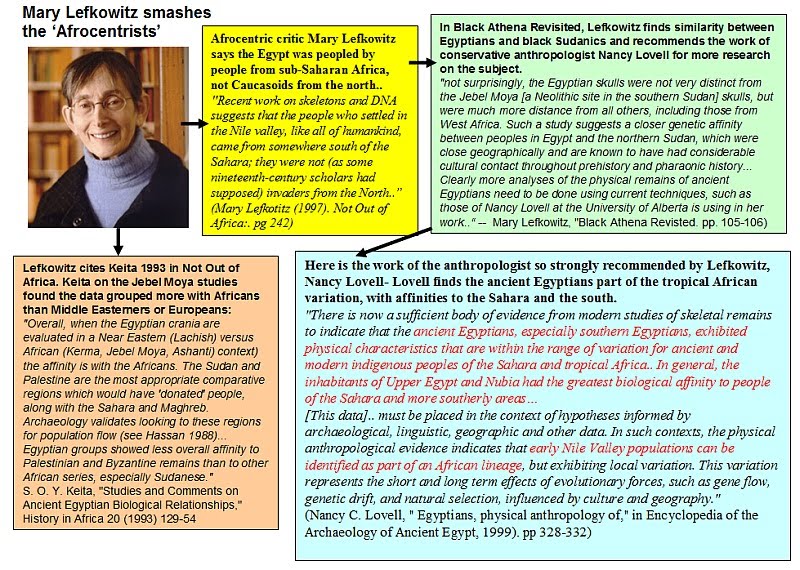
Afrocentric critic Mary Leftokwitz says Egypt was peopled by persons from sub-Saharan Africa:
"Recent work on skeletons and DNA suggests that the people who settled in the Nile valley, like all of humankind, came from somewhere south of the Sahara; they were not (as some nineteenth-century scholars had supposed) invaders from the North. See Bruce G. Trigger, "The Rise of Civilization in Egypt," Cambridge History of Africa (Cambridge, Cambridge University Press, 1982), vol I, pp 489-90; S. O. Y. Keita, "Studies and Comments on Ancient Egyptian Biological Relationships," History in Africa 20 (1993) 129-54.
(Mary Lefkotitz (1997). Not Out of Africa: How Afrocentrism Became an Excuse to Teach Myth as History. Basic Books. pg 242) [/QB][/QUOTE]
In Black Athena Revisited, Lefkowitz finds similarity between Egyptians and Sudanics and recommends the work of conservative anthropologist Nancy Lovell for more research on the subject.
Quote:
"not surprisingly, the Egyptian skulls were not very distance from the Jebel Moya skulls, but were much more distance from all others, including those from West Africa. Such a study suggests a closer genetic affinity between peoples in Egypt and the northern Sudan, which were close geographically and are known to have had considerable cultural contact throughout prehistory and pharaonic history... Clearly more analyses of the physical remains of ancient Egyptians need to be done using current techniques, such as those of Nancy Lovell at the University of Alberta is using in her work.."
Lefkotitz cites Keita 1993 in Not Out of Africa. Here is Keita on the Jebel Moya studies?
"Overall, when the Egyptian crania are evaluated in a Near Eastern (Lachish) versus African (Kerma, Jebel Moya, Ashanti) context) the affinity is with the Africans. The Sudan and Palestine are the most appropriate comparative regions which would have 'donated' people, along with the Sahara and Maghreb. Archaeology validates looking to these regions for population flow (see Hassan 1988)... Egyptian groups showed less overall affinity to Palestinian and Byzantine remains than to other African series, especially Sudanese." [/img]
S. O. Y. Keita, "Studies and Comments on Ancient Egyptian Biological Relationships," History in Africa 20 (1993) 129-54[/i]
Here is the work of the anthropologist so strongly recommended by Lefkowitz, Nancy Lovell:
"There is now a sufficient body of evidence from modern studies of skeletal remains to indicate that the ancient Egyptians, especially southern Egyptians, exhibited physical characteristics that are within the range of variation for ancient and modern indigenous peoples of the Sahara and tropical Africa.. In general, the inhabitants of Upper Egypt and Nubia had the greatest biological affinity to people of the Sahara and more southerly areas." (Nancy C. Lovell, " Egyptians, physical anthropology of," in Encyclopedia of the Archaeology of Ancient Egypt, ed. Kathryn A. Bard and Steven Blake Shubert, ( London and New York: Routledge, 1999) pp 328-332)
and
"must be placed in the context of hypotheses informed by archaeological, linguistic, geographic and other data. In such contexts, the physical anthropological evidence indicates that early Nile Valley populations can be identified as part of an African lineage, but exhibiting local variation. This variation represents the short and long term effects of evolutionary forces, such as gene flow, genetic drift, and natural selection, influenced by culture and geography." ("Nancy C. Lovell, " Egyptians, physical anthropology of," in Encyclopedia of the Archaeology of Ancient Egypt, ed. Kathryn A. Bard and Steven Blake Shubert, ( London and New York: Routledge, 1999). pp 328-332)
Obviously, this shows that the Egyptians were completely white, and how foolish the Afrocentrists are to reject this notion. After all Afrocentric critic Mary Lefkowitz recommends Lovell's research..
The same Nancy Lovell recommended by Lefkowitz studied dental traits among some high status persons of the key Egyptian Naqada group and found that they resembled the peoples of Nubia.
T. Prowse, and N. Lovell "Concordance of cranial and dental morphological traits and evidence for endogamy in ancient Egypt"
American journal of physical anthropology. 1996, vol. 101, no2, pp. 237-246 (2 p.1/4)
A biological affinities study based on frequencies of cranial nonmetric traits in skeletal samples from three cemeteries at Predynastic Naqada, Egypt, confirms the results of a recent nonmetric dental morphological analysis. Both cranial and dental traits analyses indicate that the individuals buried in a cemetery characterized archaeologically as high status are significantly different from individuals buried in two other, apparently non-elite cemeteries and that the non-elite samples are not significantly different from each other. A comparison with neighboring Nile Valley skeletal samples suggests that the high status cemetery represents an endogamous ruling or elite segment of the local population at Naqada, which is more closely related to populations in northern Nubia than to neighboring populations in southern Egypt.
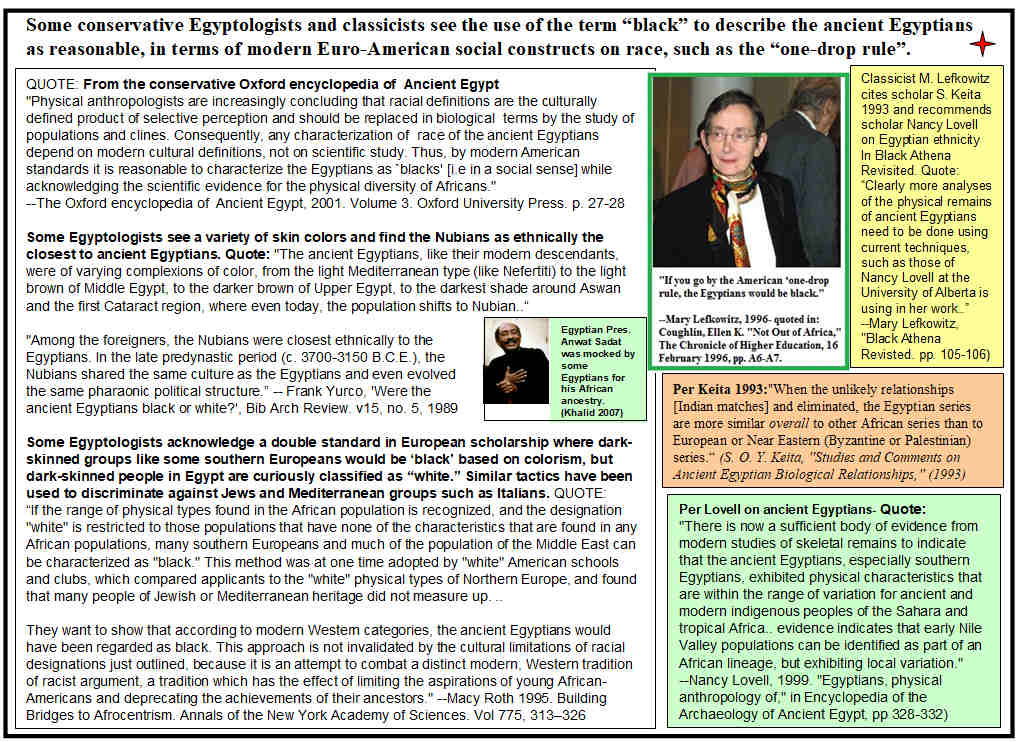
Lefkowitz warns against Eurocentric "racial" analysis as to the Egyptians and Nubians.
Quote:
"The Nubian tribute-bearers are painted in two skin tones, black and dark brown. These tones do not necessarily represent actual skin tones in real life but may serve to distinguish each tribute-bearer from the next in a row in which the figures overlap. Alternatively, the brown-skinned people may be of Nubian origin, and the black-skinned ones may be farther south 9Trigger 1978, 33). The shading of skin tones in Egyptian tomb paintings, which varies considerably, may not be a certain criterion for distinguishing race. Specific symbols of ethnic identity can also vary. Identifying race in Egyptian representational art, again, is difficult to do- probably because race (as opposed to ethnic affiliation, that is, Egyptians versus all non-Egyptians) was not a criterion for differentiation used by the ancient Egyptians...
Northern Egypt shows more physical variation than the south, but not necessarily as part of any significant 'race' mix, but local, built-in variation. They were closer to southerners than any other peoples. In comparisons with "Middle Eastern" populations of the same ancient period, the Egyptians link more closely with other Africans than the Middle Easterners. Africans vary in how they look because they have the highest built-in molecular diversity to begin with.
QUOTE(s):
"..sample populations available from northern Egypt from before the 1st Dynasty (Merimda, Maadi and Wadi Digla) turn out to be significantly different from sample populations from early Palestine and Byblos, suggesting a lack of common ancestors over a long time. If there was a south-north cline variation along the Nile valley it did not, from this limited evidence, continue smoothly on into southern Palestine. The limb-length proportions of males from the Egyptian sites group them with Africans rather than with Europeans." (Barry Kemp, "Ancient Egypt Anatomy of a Civilisation. (2005) Routledge. p. 52-60)
"Individuals from different geographical regions frequently plotted near each other, revealing aspects of variation at the level of individuals that is obscured by concentrating on the most distinctive facial traits once used to construct ''types.''The high level of African interindividual variation in craniometric pattern is reminiscent of the great level of molecular diversity found in Africa." (S.O.Y Keita. Exploring northeast African metric craniofacial variation at the individual level: A comparative study using principal component analysis. Am. J. Hum. Biol. 16:679-689, 2004.)
Quote on northern Egypt analysis- the Qarunian (Faiyum) remains (c. 7000 BC)
"The body was that of a forty-year old woman with a height of about 1.6 meters, who was of a more modern racial type than the classic 'Mechtoid' of the Fakhurian culture (see pp. 65-6), being generally more gracile, having large teeth and thick jaws bearing some resemblance to the modern 'negroid' type." (Beatrix Midant-Reynes, Ian Shaw (2000). The Prehistory of Egypt. Wiley-Blackwell. pg. 82)
Modern studies show diversity in how people look is heavily based on distance from sub-Saharan Africa, not merely climate. In genetically diverse Africa, broad-nosed people live on the cool or cold mountain slopes of East Africa or the hot, dry Sahara, and narrow-nosed peoples like many Fulani like in the wet tropics of West Africa. Yellowish-skinned San tribes live in the hot zones of Southern Africa.
"The relative importance of ancient demography and climate in determining worldwide patterns of human within-population phenotypic diversity is still open to debate. Several morphometric traits have been argued to be under selection by climatic factors, but it is unclear whether climate affects the global decline in morphological diversity with increasing geographical distance from sub-Saharan Africa. Using a large database of male and female skull measurements, we apply an explicit framework to quantify the relative role of climate and distance from Africa. We show that distance from sub-Saharan Africa is the sole determinant of human within-population phenotypic diversity, while climate plays no role. By selecting the most informative set of traits, it was possible to explain over half of the worldwide variation in phenotypic diversity. These results mirror those previously obtained for genetic markers and show that 'bones and molecules' are in perfect agreement for humans." (Distance from Africa, not climate, explains within-population phenotypic diversity in humans. (2008) by: Lia Betti, François Balloux, William Amos, Tsunehiko Hanihara, Andrea Manica, Proceedings B: Biological Sciences, 2008/12/02)
Analysis of skeletal and cranial remains reveals that the ancient Egyptians of the early Dynastic and pre-Dynastic phases, link closer to nearby Saharan, Sudanic and East African populations than Mediterranean and Middle Eastern peoples. Greeks, Romans, Hyskos, Arabs and others were to appear later in Egyptian history. Craniometric studies generally place ancient Upper Egyptian populations closer to the range of tropical Africans in the Nile Valley and East Africa than to Mediterraneans, or Middle Easterners.
QUOTE(s):
S. O. Y. Keita, "Studies and Comments on Ancient Egyptian Biological Relationships," History in Africa 20 (1993) 129-54
"Overall, when the Egyptian crania are evaluated in a Near Eastern (Lachish) versus African (Kerma, Kebel Moya, Ashanti) context) the affinity is with the Africans. The Sudan and Palestine are the most appropriate comparative regions which would have 'donated' people, along with the Sahara and Maghreb. Archaeology validates looking to these regions for population flow (see Hassan 1988)... Egyptian groups showed less overall affinity to Palestinian and Byzantine remains than to other African series, especially Sudanese." (Keita 1993)
"When the unlikely relationships [Indian matches] and eliminated, the Egyptian series are more similar overall to other African series than to European or Near Eastern (Byzantine or Palestinian) series." (Keita 1993)
"Populations and cultures now found south of the desert roamed far to the north. The culture of Upper Egypt, which became dynastic Egyptian civilization, could fairly be called a Sudanese transplant."(Egypt and Sub-Saharan Africa: Their Interaction. Encyclopedia of Precolonial Africa, by Joseph O. Vogel, AltaMira Press, Walnut Creek, California (1997), pp. 465-472 )
"Analysis of crania is the traditional approach to assessing ancient population origins, relationships, and diversity. In studies based on anatomical traits and measurements of crania, similarities have been found between Nile Valley crania from 30,000, 20,000 and 12,000 years ago and various African remains from more recent times (see Thoma 1984; Brauer and Rimbach 1990; Angel and Kelley 1986; Keita 1993). Studies of crania from southern predynastic Egypt, from the formative period (4000-3100 B.C.), show them usually to be more similar to the crania of ancient Nubians, Kushites, Saharans, or modern groups from the Horn of Africa than to those of dynastic northern Egyptians or ancient or modern southern Europeans."
(S. O. Y and A.J. Boyce, "The Geographical Origins and Population Relationships of Early Ancient Egyptians", in Egypt in Africa, Theodore Celenko (ed), Indiana University Press, 1996, pp. 20-33)
"There is no archaeological, linguistic, or historical data which indicate a European or Asiatic invasion of, or migration to, the Nile Valley during First Dynasty times. Previous concepts about the origin of the First Dynasty Egyptians as being somehow external to the Nile Valley or less native are not supported by archaeology... In summary, the Abydos First Dynasty royal tomb contents reveal a notable craniometric heterogeneity. Southerners predominate. (Kieta, S. (1992) Further Studies of Crania From Ancient Northern Africa: An Analysis of Crania From First Dynasty Egyptian Tombs, Using Multiple Discriminant Functions. AMERICAN JOURNAL OF PHYSICAL ANTHROPOLOGY 87:245-254)"
"The predominant craniometric pattern in the Abydos royal tombs is 'southern' (tropical African variant), and this is consistent with what would be expected based on the literature and other results (Keita, 1990). This pattern is seen in both group and unknown analyses... Archaeology and history seem to provide the most parsimonious explanation for the variation in the royal tombs at Abydos.. Tomb design suggests the presence of northerners in the south in late Nakada times (Hoffman, 1988) when the unification probably took place. Delta names are attached to some of the tombs at Abydos (Gardiner, 1961; Yurco, 1990, personal communication), thus perhaps supporting Petrie's (1939) and Gardiner's contention that north-south marriages were undertaken to legitimize the hegemony of the south. The courtiers of northern elites would have accompanied them.
Given all of the above, it is probably not possible to view the Abydos royal tomb sample as representative of the general southern Upper Egyptian population of the time. Southern elites and/or their descendants eventually came to be buried in the north (Hoffman, 1988). Hence early Second Dynasty kings and Djoser (Dynasty 111) (Hayes, 1953) and his descendants are not buried in Abydos. Petrie (1939) states that the Third Dynasty, buried in the north, was of Sudanese origin, but southern Egypt is equally likely. This perhaps explains Harris and Weeks' (1973) suggested findings of southern morphologies in some Old Kingdom Giza remains, also verified in portraiture (Drake, 1987). Further study would be required to ascertain trends in the general population of both regions. The strong Sudanese affinity noted in the unknown analyses may reflect the Nubian interactions with upper Egypt in predynastic times prior to Egyptian unification (Williams, 1980,1986)..." (S. Keita (1992) Further Studies of Crania From Ancient Northern Africa: An Analysis of Crania From First Dynasty Egyptian Tombs, Using Multiple Discriminant Functions. AMERICAN JOURNAL OF PHYSICAL ANTHROPOLOGY 87:245-254)
"When the Elephantine results were added to a broader pooling of the physical characteristics drawn from a wide geographic region which includes Africa, the Mediterranean and the Near East quite strong affinities emerge between Elephantine and populations from Nubia, supporting a strong south-north cline. (Barry Kemp. (2006) Ancient Egypt: Anatomy of a Civilization. p. 54)
Gene flow into the Nubian area during the Neolithic was not from reputed "wandering Caucasoids" but from tropical, Sub-Saharan types.
"Prior to the Neolithic, populations of the Nile Valley in Nubia are very robust, and, because of a gap in the fossil record, it is difficult to connect them to later populations. Some have postulated a local evolution, due to diet change, while others postulated migrations, especially from the Sahara area. But between 5000 and 1000 BC, many cemeteries have supplied a large amount of skeletons, and the anatomical characters of Nubian populations are easier to follow-up. Twenty-seven archaeological samples (4 at 5000 BC, 5 at 4000 BC, 10 at 3000 BC, 3 at 2000 BC, 5 at 1000 BC), and 10 craniofacial measurements, have been considered. While cerebral skull is fairly stable, facial skull displays several regular modifications, and specially a reduction of facial and nasal heights, a broadening of the nose, and an increase of prognathism, while bizygomatic breadth is unchanged. These features illustrate a trend towards a growing resemblance with populations of Sub-Saharan Africa living in wet environments. However, paleoclimatological studies show that Nubia experienced an increasing aridification during that period. It is then unlikely that such a morphological change could be related to any local adaptive evolution to environment. Random drift is also unlikely, because the anatomical trend is relatively uniform during these millennia. It then seems more plausible that these changes correspond to the increasing presence of Southern populations migrating northward."
-- Froment, A. (2002) Morphological micro-evolution of Nubian Populations from, A-Group to Christian Epochs: gene flow, not local adaptation. Am J Phys Anthropol [Suppl] 34:72.
Afrocentric critic Froment also notes:
"Black populations of the Horn of Africa (Tigré and Somalia) fit well into Egyptian variations." (Froment, Alain, Origines du peuplement de l’Égypte ancienne: l’apport de l’anthropobiologie, Archéo-Nil 2 (Octobre 1992), 79-98)
Afrocentric critic C. Loring Brace's 2005 study groups ancient Egyptian populations like the Naqada closer to Nubians and Somalis than European, Mediterranean or Middle Eastern populations. Brace's study shows that the closest European linking with Africans in Egypt or Nubia are Middle Stone Age Portugese and Neolithics, OLDER populations more closely resembling AFRICANS than modern Europeans. Early Neolithic populations, like the Nautifians, in what is now Israel, show sub-Saharan 'negroid' affinities. (Brace, et al. The questionable contribution of the Neolithic and the Bronze Age to European craniofacial form, Proc Natl Acad Sci U S A. 2006 January 3; 103(1): p. 242-247.)
"The Niger-Congo speakers, Congo, Dahomey and Haya, cluster closely with each other and a bit less closely with the Nubian sample, both the recent and the Bronze Age Nubians, and more remotely with the Naqada Bronze Age sample of Egypt, the modern Somalis, and the Arabic-speaking Fellaheen (farmers) of Israel. When those samples are separated and run in a single analysis as in Fig. 1, there clearly is a tie between them that is diluted the farther one gets from sub-Saharan Africa" (Brace, 2005)
"The surprise is that the Neolithic peoples of Europe and their Bronze Age successors are not closely related to the modern inhabitants, although the prehistoric/modern ties are somewhat more apparent in southern Europe. It is a further surprise that the Epipalaeolithic Natufian of Israel from whom the Neolithic realm was assumed to arise has a clear link to Sub-Saharan Africa... Interestingly enough, however, the small Natufian sample falls between the Niger-Congo group and the other samples used. Fig. 2 shows the plot produced by the first two canonical variates, but the same thing happens when canonical variates 1 and 3 (not shown here) are used. This placement suggests that there may have been a Sub-Saharan African element in the make-up of the Natufians (the putative ancestors of the subsequent Neolithic), .. When canonical variates are plotted, neither sample ties in with Cro-Magnon as was once suggested. The data treated here support the idea that the Neolithic moved out of the Near East into the circum-Mediterranean areas and Europe by a process of demic diffusion but that subsequently the in situ residents of those areas, derived from the Late Pleistocene inhabitants, absorbed both the agricultural life way and the people who had brought it." (Brace, 2005)
Both skeletal/cranial and DNA studies by other authors confirm that some Neolithics did not derive from the Near East. They most likely resembled African populations. Hence comparisons using older European Neolithics versus Africans are comparisons with older prehistoric Europeans who looked more like Africans, than modern 'white' Europeans, as shown by Brace (2005), and Hanihara (1996) also, who states "Early West Asians looked like Africans."
"The absence of mtDNA haplogroup J in the ancient Portuguese Neolithic sample suggests that this population was not derived directly from Near Eastern farmers. The Mesolithic and Neolithic groups show genetic discontinuity implying colonisation at the Neolithic transition in Portugal." (CHANDLER, H.; SYKES, B.; ZILHÃO, J. (2005) - Using ancient DNA to examine genetic continuity at the Mesolithic-Neolithic transition in Portugal, in ARIAS, P.; ONTAÑÓN, R.; GARCÍA-MONCÓ, C. (eds.) - «Actas del III Congreso del Neolítico en la Península Ibérica», Santander, Monografías del Instituto Internacional de Investigaciones Prehistóricas de Cantabria 1, p. 781-786.)
"Early Europeans still resembled modern tropical peoples - some resemble modern Australian and Africans, more than modern Europeans.. Nor does the picture get any clearer when we move on to the Cro-Magnons, the presumed ancestors of modern Europeans. Some were more like present-day Australians or Africans, judged by objective anatomical observations." (Christopher Stringer, Robin McKie (1998). African Exodus. Macmillan, p. 162)
Early Europeans, as recently as 6,000-9000 years ago, looked somewhat like Africans in terms of retained 'tropical' characteristics. Cold adaptation was to bring about several physical changes over time from the initial Out of Africa migrations to Europe. Retained traces of 'tropical' characteristics, indicate a "large African role in the origins of anatomically modern Europeans." (Holliday and Churchill 2003).
"Body proportions covary with climate, apparently as the result of climatic selection. Ontogenetic research and migrant studies have demonstrated that body proportions are largely genetically controlled and are under low selective rates; thus studies of body form can provide evidence for evolutionarily short-term dispersals and/or gene flow. Replacement predicts that the earliest modern Europeans will possess "tropical" body proportions (assuming Africa is the center of origin), while Regional Continuity permits only minor shifts in body shape, due to climatic change and/or improved cultural buffering. .. results refute the hypothesis of local continuity in Europe, and are consistent with an interpretation of elevated gene flow (and population dispersal?) from Africa, followed by subsequent climatic adaptation to colder conditions." (Holliday, Trenton (1997) Body proportions in Late Pleistocene Europe and modern human origins. Journal of Human Evolution, Volume 32, Issue 5, 1997, Pages 423-447)
".. while the Late Upper Paleolithic and Mesolithic humans have significantly higher (i.e., tropically-adapted) brachial and crural indices than do recent Europeans, they also have shorter (i.e., cold-adapted) limbs. The somewhat paradoxical retention of "tropical" indices in the context of more "cold-adapted" limb length is best explained as evidence for Replacement in the European Late Pleistocene, followed by gradual cold adaptation in glacial Europe." (Holliday, Trenton (1999) Brachial and crural indices of European Late Upper Paleolithic and Mesolithic humans. Journal of Human Evolution. Volume 36, Issue 5, May 1999, Pages 549-566)
"Stature, body mass, and body proportions are evaluated for the Cheddar Man (Gough's Cave 1) skeleton. Like many of his Mesolithic contemporaries, Gough's Cave 1 evinces relatively short estimated stature (ca. 166.2 cm [5' 5']) and low body mass (ca. 66 kg [146 lbs]). In body shape, he is similar to recent Europeans for most proportional indices. He differs, however, from most recent Europeans in his high crural index and tibial length/trunk height indices. Thus, while Gough's Cave 1 is characterized by a total morphological pattern considered 'cold-adapted', these latter two traits may be interpreted as evidence of a large African role in the origins of anatomically modern Europeans." (TRENTON W. HOLLIDAY a1 and STEVEN E. CHURCHILL. (2003). Gough's Cave 1 (Somerset, England): an assessment of body size and shape, Bulletin of the Natural History Museum: Geology, 58:37-44 Cambridge University Press)
More data showing early Europeans were tropically adapted types like Africans
"Body proportions are under strong climatic selection and evince remarkable stability within regional lineages. As such, they offer a viable and robust alternative to cranio-facial data in assessing hypothesised continuity and replacement with the transition to agro-pastoralism in central Europe. Humero-clavicular, brachial and crural indices in a large sample (n=75) of Linienbandkeramik (LBK), Late Neolithic and Early Bronze Age specimens from the middle Elbe-Saale-Werra valley (MESV) were compared with Eurasian and African terminal Pleistocene, European Mesolithic and geographically disparate recent human specimens. Mesolithic Europeans display considerable variation in humero-clavicular and brachial indices yet none approach the extreme "hyper-polar" morphology of LBK humans from the MESV. In contrast, Late Neolithic and Early Bronze Age peoples display elongated brachial and crural indices reminiscent of terminal Pleistocene and "tropically adapted" recent humans. These marked morphological changes likely reflect exogenous immigration during the terminal Fourth millennium cal BC. Population expansion and diffusion is a function of increased mobility and settlement dispersal concomitant with significant technological and subsistence changes in later Neolithic societies during the late fourth millennium cal BCE."
-- Gallagher et al. "Population continuity, demic diffusion and Neolithic origins in central-southern Germany: the evidence from body proportions." Homo. 2009;60(2):95-126. Epub 2009 Mar 4.

1) The ultimate purpose of the database is not "debate" as such, but to develop a deeper, wider and more accurate knowledge of African bio-cultural history and diversity, including ALL of Africa not just so-called "sub-Saharan" Africa. "Sub-Saharan" Africa- is itself an oft stereotypical concept given that African peoples do move around and are not bound by any 'apartheid' geographic barrier, and the movement of said 'barrier' southwards means that people once "sub-Saharan' become "non Sub Saharan" as the years pass. Fabled Timbuktu for example is now "non African" or "non black" since shifting sands have moved south. Ethiopia though still remains "sub-Saharan." The database seeks to present (a) a more balanced view of African diversity- biological, cultural, historical, geographical, etc, and (b) a more accurate picture of that diversity - (setting the record straight). As part of this, various chauvinisms, whether of the EUrocentric, Arabist, Afrocentric or 'Nativist' modern Egyptian varieties are given short shrift.
Note: this database relies on hard data from credible and verifiable scholarly sources- including cranial skeletal, dental, DNA archaeological, and cultural data. This is why so many citations and quotations are used. The reader is invited to verify all for themselves, and they are clearly given. Persons looking for more personal "feelings," mystical content, or support for extreme claims about no outsiders entering Africa until Greeks or Arabs showed up, or assorted absolutist "Afrocentric" statements, or dubious 'albina Caucasia' or racialist and anti-semitic "hereditarian" theories are advised to look elsewhere. Likewise folk holding to stereotypical "true negro" models re Africa and Africans will find their views and claims thoroughly debunked herein. While social constructs are an integral part of the background, and indeed the field at some level, hard specialist data, including that of credible historians, is the main thrust. The database also takes in more than Kemet or Egypt but touches heavily on the great diversity of Africa and African peoples. It is not "only" about Kemet and indeed, that diversity clearly demonstrates that Kemet is an integral part of Africa and its bio-cultural environment. Africa is the great source from which Kemet and other African civilizations sprung, not the other way around. This grassroots, "bottom up" approach guides the format.

But why, some ask? Unfortunately, a pattern of distortion and unbalanced scholarship continues to appear in the field. One recent critique of a recent ancient DNA study on ancient Egypt, exemplifies the case, with the study implying that ancient Egyptians came from the Asia, and that "sub-Saharan" African patterns in Egypt are recent due to the Islamic slave trades. Note this critique is by credible, mainstream, peer-review scholars not "random bloggers off the web." One would think that in 2022, with many in the academy having advanced degrees, backing by heavyweight universities and/or private institutions, and full tranches of grant money that there would be better, more balanced research. But this is not the case- as the critique shows: egyptsearchreloaded.proboards.com/post/18214
Many other examples of shortchanging of African diversity, exclusion of relevant data and stereotypical thinking are given herein, and the pattern is repeated in college textbooks and in the AP/Honors textbooks being taught to high school students.
2) Explanatory headings, titles or summaries are generally given in boldface, followed by a detailed quotation from a scholarly article or book on the subject. Do not mix up headings/titles with the actual quotation.
3) Read the material carefully, including titles/headings and do not simply copy it here and there without reading and understanding.
4) Many titles/headings are qualified- that is they try not to go beyond what the particular evidentiary source is saying. Make your best argument as you will, but at least have some reasonable backup- do not jump to extreme conclusions or claims that are not supported by evidence. If a heading says "some" or "in certain eras" that's exactly what it means- "some," and during those particular times. Do not leap beyond the data and claim ALL conditions, possibilities, times or scenarios are covered. "Some" is not the same as "all" - a point some "enthusiasts" seem to have missed. Despite this warning, a number of said "enthusiasts" have taken to stretching the data in misleading ways, including attempting to shoehorn "Dravidians" from India into Kemet or Nubian culture, or having ancient "Niger-Congo" migrants "fleeing" from Egypt to West Africa to bring civilization when Persians showed up on the Nile. Such stretched "diffusionist" interpretations are not warranted from the data, nor "endorsed" anywhere here. If any are attempting to conjure some sort of "Afro" strawman out of the data here, you have already failed.
5) The data works as a FLEXIBLE COMBINED ARMS package - multiple lines of evidence: Skeletal, cranial, dental, DNA, cultural, religious, geographical, archaeological and others. These multiple lines support one another. Do not rely on one thing only. The overall base is an anvil, upon which all these other hammers strike. In this business knowledge does not stay static. Be ready to adjust your arguments or thinking where warranted by confirming data. Be ready to adjust, AND wield the hammers, while holding the core principles of the anvil (African diversity) firm.
6) ALWAYS KEEP IN MIND THE CENTRAL POINT OF THE DIVERSITY OF AFRICANS- VIGOROUSLY REJECT AND ATTACK ALL STEREOTYPICAL CONSTRUCTS. African diversity is based on hard data from multiple lines. Fiercely reject any "true negro" insinuation and construct. Reject any attempts to limit African culture and/or movement to some sort of artificial "sub-Saharan" stereotype. Africans can move around and have from Asia, to Europe and beyond. They are not "confined" to "sub-Saharan" locales. They can develop writing, build cities, create empires without needing any "wandering Caucasoids." And maintain the view of tropical Africans- they extend from southern Africa to southern Egypt. "Tropical" does not just mean "jungle" or "savanna." And Africans have the greatest phenotypic and genetic diversity- they can have narrow noses, light skin, loose hair, etc etc- as part of BUILT-IN native variety, without needing any "race mix" to explain why. Hard data confirms this diversity. Always insist on it.

7. Social constructs such as the European-American "one-drop" rule are a reality for many, but are a secondary consideration. Old questions such as "whether the Egyptians are black" are not foremost. The label "black" is a social construct- and certainly using racial social constructs developed by Europeans and Americans, Ancient Egyptians can be consistently and reasonably be labeled as "black." On this agree specialist Egyptologists (Tyson-Smith 2001) along with others, and balanced analyses such as that of archaeologists and other scholars like Dr. Marie Gatto, (University of Leicester), or Dr. Sally-Ann Ashton(Department of Antiquities at the Fitzwilliam Museum, University of Cambridge), further confirms the case of data. But such labels are peripheral to the PRIMARY consideration- the African character and foundations of not only Kemet but all the classical Nile Valley Civilizations. Hence "social construct blackness" is not at the top of the list of things to focus on. This database relies on hard data- skeletal, DNA, cranial, cultural, dental etc that demonstrates that African character and foundation. It does not revolve around social construct labels. A focus on labels is often used to divert attention from the hard data making the case. While labels are a valid and important consideration for discussion (especially since the enemies of a balanced African bio-cultural narrative keep on using them), they are a secondary element compared to the solid body of hard evidence and data herein. Do not let the labeling game overshadow the hard evidence. This is precisely what opponents often want, so they can sidetrack and divert discussion by invoking "politics." You can contradict opponents with their own labeling game but remember, data makes the case.
8) Finally, maintaining a balanced view of African bio-cultural history and diversity, at times will require (a) unapologetic confrontation (see for example) and aggressive defense on behalf of African peoples, and (b) relentless exposure of Eurocentric and Arabist/'Nativist' hypocrisy. Recognize that at times your activities will not be so much to persuade intellectually dishonest opponents, propagandists or racists of the hard or "soft" variety- it will be to hit them hard.
See for example a thorough debunking of assorted Arabists, Antisemite and racist mentalities below:
egyptsearchreloaded.proboards.com/thread/3513/blast-past-racists-arabists-antisemites
Much of this info drives an extremely sharp and threatening blade into the heart of cherished supremacist narratives, myths and constructs. This includes claims advanced by so-called 'nativists' who keep denying the African background of Kemet, including its peopling by indigenous tropical Africans- as if ancient Egyptians spontaneously sprang up out of the Nile- remnants of the crocodile gods and frog goddesses who attended upon Hapi, deity of the Nile. Whatever their guise, drive home data harpoons vigorously, as the need arises. At other times you will meet more reasonable people who will hold honest dialog, and can be persuaded, or at least joined in a respectful exchange of views, using not emotional appeals but clear logic and data. With these genuine people a less aggressive tone can be taken, and to be sure, we all can agree to disagree at the end of the day. This is fine. But be aware that distorting, hypocritical opponents will appear aplenty. Load for bear, and shoot accordingly.
x
links- site excample
www.nairaland.com/2335643/how-africa-break-lose-western
----------------------------------------------------------------------------------------------------------------------

Recent studies find the ancient Egyptians had a tropical body plan like sub-Saharan 'black' Africans and were not cold-adapted like European type populations. Tropical body plans also indicate darker-skin.
QUOTE:
"The raw values in Table 6 suggest that Egyptians had the "super-Negroid" body plan described by Robins (1983).. This pattern is supported by Figure 7 (a plot of population mean femoral and tibial lengths; data from Ruff, 1994), which indicates that the Egyptians generally have tropical body plans. Of the Egyptian samples, only the Badarian and Early Dynastic period populations have shorter tibiae than predicted from femoral length. Despite these differences, all samples lie relatively clustered together as compared to the other populations." (Zakrzewski, S.R. (2003). "Variation in ancient Egyptian stature and body proportions". American Journal of Physical Anthropology 121 (3): 219-229.
a 2008 Study puts the ancient Egyptians closer to US Blacks than whites:
Quotes:
"Intralimb (crural and brachial) indices are significantly higher in ancient Egyptians than in American Whites (except crural index among females), i.e., Egyptians have relatively longer distal segments (Table 4). Intralimb indices are not significantly different between Egyptians and American Blacks... Many of those who have studied ancient Egyptians have commented on their characteristically ''tropical'' or ''African'' body plan (Warren, 1897; Masali, 1972; Robins, 1983; Robins and Shute, 1983, 1984, 1986; Zakrzewski, 2003). Egyptians also fall within the range of modern African populations (Ruff and Walker, 1993), but close to the upper limit of modern Europeans as well, at least for the crural index (brachial indices are definitely more ''African'').. In terms of femoral and tibial length to total skeletal height proportions, we found that ancient Egyptians are significantly different from US Blacks, although still closer to Blacks than to Whites.
Comparisons of linear body proportions of Old Kingdom and non-Old Kingdom period individuals, and workers and high officials in our sample found no statistically significant differences among them. Zakrzewski (2003) also found little evidence for differences in linear body proportions of Egyptians over a wider temporal range. In general, recent studies of skeletal variation among ancient Egyptians support scenarios of biological continuity through time. Irish (2006) analyzed quantitative and qualitative dental traits of 996 Egyptians from Neolithic through Roman periods, reporting the presence of a few outliers but concluding that the dental samples appear to be largely homogeneous and that the affinities observed indicate overall biological uniformity and continuity from Predynastic through Dynastic and Postdynastic periods.
Zakrzewski (2007) provided a comprehensive summary of previous Egyptian craniometric studies and examined Egyptian crania from six time periods. She found that the earlier samples were relatively more homogeneous in comparison to the later groups. However, overall results indicated genetic continuity over the Egyptian Predynastic and Early Dynastic periods, albeit with a high level of genetic diversity within the population, suggesting an indigenous process of state formation. She also concluded that while the biological patterning of the Egyptian population varied across time, no consistent temporal or spatial trends are apparent. Thus, the stature estimation formulae developed here may be broadly applicable to all ancient Egyptian populations.."
("Stature estimation in ancient Egyptians: A new technique based on anatomical reconstruction of stature." Michelle H. Raxter, Christopher B. Ruff, Ayman Azab, Moushira Erfan, Muhammad Soliman, Aly El-Sawaf, (Am J Phys Anthropol. 2008, Jun;136(2):147-55
Older limb studies find the same: [/b]
"In this regard it is interesting to note that limb proportions of Predynastic Naqada people in Upper Egypt are reported to be "Super-Negroid," meaning that the distal segments are elongated in the fashion of tropical Africans.....skin color intensification and distal limb elongation are apparent wherever people have been long-term residents of the tropics." (C.L. Brace, 1993. Clines and clusters..")
"An attempt has been made to estimate male and female Egyptian stature from long bone length using Trotter & Gleser negro stature formulae, previous work by the authors having shown that these rather than white formulae give more consistent results with male dynastic material... When consistency has been achieved in this way, predynastic proportions are founded to be such that distal segments of the limbs are even longer in relation to the proximal segments than they are in modern negroes. Such proportions are termed "super-negroid"...
Robins (1983) and Robins & Shute (1983) have shown that more consistent results are obtained from ancient Egyptian male skeletons if Trotter & Gleser formulae for negro are used, rather than those for whites which have always been applied in the past. .. their physical proportions were more like modern negroes than those of modern whites, with limbs that were relatively long compared with the trunk, and distal segments that were long compared with the proximal segments. If ancient Egyptian males had what may be termed negroid proportions, it seems reasonable that females did likewise."
(Robins G, Shute CCD. 1986. Predynastic Egyptian stature and physical proportions. Hum Evol 1:313-324. Ruff CB. 1994.)

Modern anthropology shows that the ancient Egyptians are well within the range of tropical Africa, contradicting older research in the 1990s that sought to deny any relationship. The anthropologist below, Nancy Lovell was recommended by Mary lefkowitz in Black Athena Revisted.
"There is now a sufficient body of evidence from modern studies of skeletal remains to indicate that the ancient Egyptians, especially southern Egyptians, exhibited physical characteristics that are within the range of variation for ancient and modern indigenous peoples of the Sahara and tropical Africa.. In general, the inhabitants of Upper Egypt and Nubia had the greatest biological affinity to people of the Sahara and more southerly areas." (Nancy C. Lovell, " Egyptians, physical anthropology of," in Encyclopedia of the Archaeology of Ancient Egypt, ed. Kathryn A. Bard and Steven Blake Shubert, ( London and New York: Routledge, 1999) pp 328-332)
The ancient Badarians were quite representative of ancient Egyptians as a whole and showed clear links with tropical Africans to the south. They have been sometimes excluded in studies of the ancient Egyptian population, which shows continuity in its history, not mass influxes of foreigners until the late periods.
Quotes:
"As a result of their facial prognathism, the Badarian sample has been described as forming a morphological cluster with Nubian, Tigrean, and other southern (or "Negroid") groups (Morant, 1935, 1937; Mukherjee et al., 1955; Nutter, 1958, Strouhal, 1971; Angel, 1972; Keita, 1990). Cranial nonmetric trait studies have found this group to be similar to other Egyptians, including much later material (Berry and Berry, 1967, 1972), but also to be significantly different from LPD material (Berry et al., 1967). Similarly, the study of dental nonmetric traits has suggested that the Badarian population is at the centroid of Egyptian dental samples (Irish, 2006), thereby suggesting similarity and hence continuity across Egyptian time periods. From the central location of the Badarian samples in Figure 2, the current study finds the Badarian to be relatively morphologically close to the centroid of all the Egyptian samples. The Badarian have been shown to exhibit
greatest morphological similarity with the temporally successive EPD (Table 5). Finally, the biological distinctiveness
of the Badarian from other Egyptian samples has also been demonstrated (Tables 6 and 7).
These results suggest that the EDyn do form a distinct morphological pattern. Their overlap with other Egyptian samples (in PC space, Fig. 2) suggests that although their morphology is distinctive, the pattern does overlap with the other time periods. These results therefore do not support the Petrie concept of a \Dynastic race" (Petrie, 1939; Derry, 1956). Instead, the results suggest that the Egyptian state was not the product of mass movement of populations into the Egyptian Nile region, but rather that it was the result of primarily indigenous development combined with prolonged small-scale migration, potentially from trade, military, or other contacts.
This evidence suggests that the process of state formation itself may have been mainly an indigenous process, but that it may have occurred in association with in-migration to the Abydos region of the Nile Valley. This potential in-migration may have occurred particularly during the EDyn and OK. A possible explanation is that the Egyptian state formed through increasing control of trade and raw materials, or due to military actions, potentially associated with the use of the Nile Valley as a corridor for prolonged small scale movements through the desert environment.
(Sonia R. Zakrzewski. (2007). Population Continuity or Population Change: Formation of the Ancient Egyptian State. AMERICAN JOURNAL OF PHYSICAL ANTHROPOLOGY 132:501-509)

Ancient Egyptians most related to other Africans and are part of a Nilotic continuity rather than something Mediterranean or Middle Eastern
"Certainly there was some foreign admixture [in Egypt], but basically a homogeneous African population had lived in the Nile Valley from ancient to modern times... [the] Badarian people, who developed the earliest Predynastic Egyptian culture, already exhibited the mix of North African and Sub-Saharan physical traits that have typified Egyptians ever since (Hassan 1985; Yurco 1989; Trigger 1978; Keita 1990.. et al.,)... The peoples of Egypt, the Sudan, and much of East African Ethiopia and Somalia are now generally regarded as a Nilotic continuity, with widely ranging physical features (complexions light to dark, various hair and craniofacial types) but with powerful common cultural traits, including cattle pastoralist traditions.." (Frank Yurco, "An Egyptological Review," 1996 -in Mary R. Lefkowitz and Guy MacLean Rogers, Black Athena Revisited, 1996, The University of North Carolina Press, p. 62-100)
African peoples are the most diverse in the world whether analyzed by DNA or skeletal or cranial methods. Attempts to deny this are rooted in racism and error. African people, particularly SUB-SAHARAN Africans, vary the most in how they look, more so than any other population in the world.
"Estimates of genetic diversity in major geographic regions are frequently made by pooling all individuals into regional aggregates. This method can potentially bias results if there are differences in population substructure within regions, since increased variation among local populations could inflate regional diversity. A preferred method of estimating regional diversity is to compute the mean diversity within local populations. Both methods are applied to a global sample of craniometric data consisting of 57 measurements taken on 1734 crania from 18 local populations in six geographic regions: sub-Saharan Africa, Europe, East Asia, Australasia, Polynesia, and the Americas. Each region is represented by three local populations.
Both methods for estimating regional diversity show sub-Saharan Africa to have the highest levels of phenotypic variation, consistent with many genetic studies."
(Relethford, John "Global Analysis of Regional Differences in Craniometric Diversity and Population Substructure". Human Biology - Volume 73, Number 5, October 2001, pp. 629-636)
#
"In addition, craniometric variation also shows agreement with genetic data in showing highest levels of diversity in sub-Saharan Africa than in other geographic regions (Relethford and Harpending, 1994). Further, there is a clear decline in levels of craniometric variation as geographic distance from East Africa increases (Manica et al., 2007; von Cramon-Taubadel and Lycett, 2008; Betti et al., 2009)."
-- John H. Relethford* (2010). Population-Specific Deviations of Global Human Craniometric Variation From a Neutral Model. AMERICAN JOURNAL OF PHYSICAL ANTHROPOLOGY 2010
"The living peoples of the African continent are diverse in facial characteristics, stature, skin color, hair form, genetics, and other characteristics. No one set of characteristics is more African than another. Variability is also found in "sub-Saharan" Africa, to which the word "Africa" is sometimes erroneously restricted. There is a problem with definitions. Sometimes Africa is defined using cultural factors, like language, that exclude developments that clearly arose in Africa. For example, sometimes even the Horn of Africa (Somalia, Ethiopia, Eritrea) is excluded because of geography and language and the fact that some of its peoples have narrow noses and faces.
However, the Horn is at the same latitude as Nigeria, and its languages are African. The latitude of 15 degree passes through Timbuktu, surely in "sub-Saharan Africa," as well as Khartoum in Sudan; both are north of the Horn. Another false idea is that supra-Saharan and Saharan Africa were peopled after the emergence of "Europeans" or Near Easterners by populations coming from outside Africa. Hence, the ancient Egyptians in some writings have been de-Africanized. These ideas, which limit the definition of Africa and Africans, are rooted in racism and earlier, erroneous "scientific" approaches." (S. Keita, "The Diversity of Indigenous Africans," in Egypt in Africa, Theodore Clenko, Editor (1996), pp. 104-105. [10])
Modern DNA studies find even though some African peoples look different, they are genetically related through the PN2 transition clade of the Y-chromosone. Haplogroup E links numerous peoples together even though they don't look exactly the same.
"But the Y-chromosome clade defined by the PN2 transition (PN2/M35, PN2/M2) shatters the boundaries of phenotypically defined races and true breeding populations across a great geographical expanse. African peoples with a range of skin colors, hair forms and physiognomies have substantial percentages of males whose Y chromosomes form closely related clades with each other, but not with others who are phenotypically similar. The individuals in the morphologically or geographically defined 'races' are not characterized by 'private' distinct lineages restricted to each of them." (S O Y Keita, R A Kittles, et al. "Conceptualizing human variation," Nature Genetics 36, S17 - S20 (2004)

"Recall that the Horn-Nile Valley crania show, as a group, the largest overlap with other regions. A review of the recent literature indicates that there are male lineage ties between African peoples who have been traditionally labeled as being ''racially'' different, with ''racially'' implying an ontologically deep divide. The PN2 transition, a Y chromosome marker, defines a lineage (within the YAPþ derived haplogroup E or III) that emerged in Africa probably before the last glacial maximum, but after the migration of modern humans from Africa (see Semino et al., 2004). This mutation forms a clade that has two daughter subclades (defined by the biallelic markers M35/215 (or 215/M35) and M2) that unites numerous phenotypically variant African populations from the supra-Saharan, Saharan, and sub-Saharan regions.."
(S.O.Y Keita. Exploring northeast African metric craniofacial variation at the individual level: A comparative study using principal component analysis. Am. J. Hum. Biol. 16:679-689, 2004.)
keita2004neanalysis.htm
"Africa contains tremendous cultural, linguistic and genetic diversity, and has more than 2,000 distinct ethnic groups and languages.. Studies using mitochondrial (mt)DNA and nuclear DNA markers consistently indicate that Africa is the most genetically diverse region of the world." (Tishkoff SA, Williams SM., Genetic analysis of African populations: human evolution and complex disease. Nature Reviews Genetics. 2002 Aug (8):611-21.)
DNA of some modern Egyptians found a genetic ancestral heritage to East Africa:
"The mitochondrial DNA (mtDNA) diversity of 58 individuals from Upper Egypt, more than half (34 individuals) from Gurna, whose population has an ancient cultural history, were studied by sequencing the control-region and screening diagnostic RFLP markers. This sedentary population presented similarities to the Ethiopian population by the L1 and L2 macrohaplogroup frequency (20.6%), by the West Eurasian component (defined by haplogroups H to K and T to X) and particularly by a high frequency (17.6%) of haplogroup M1. We statistically and phylogenetically analysed and compared the Gurna population with other Egyptian, Near East and sub-Saharan Africa populations; AMOVA and Minimum Spanning Network analysis showed that the Gurna population was not isolated from neighbouring populations. Our results suggest that the Gurna population has conserved the trace of an ancestral genetic structure from an ancestral East African population, characterized by a high M1 haplogroup frequency. The current structure of the Egyptian population may be the result of further influence of neighbouring populations on this ancestral population."
(Stevanovitch A, Gilles A, Bouzaid E, et al. (2004) Mitochondrial DNA sequence diversity in a sedentary population from Egypt.Ann Hum Genet. 68(Pt 1):23-39.)
Tishkoff et al on Africa having the most genetic diversity:
"Africa contains tremendous cultural, linguistic and genetic diversity, and has more than 2,000 distinct ethnic groups and languages (see online link to Ethnologue). Studies using mitochondrial (mt)DNA and nuclear DNA markers consistently indicate that Africa is the most genetically diverse region of the world(TABLE 1).However,most studies report only a few markers in divergent African populations, which makes it difficult to draw general conclusions about the levels and patterns of genetic diversity in these populations (FIG. 1). Because genetic studies have been biased towards more economically developed African countries that have key research or medical centres, populations from more underdeveloped or politically unstable regions of Africa remain undersampled (FIG. 1). Historically, human population genetic studies have relied on one or two African populations as being representative of African diversity, but recent studies show extensive genetic variation among even geographically close African populations, which indicates that there is not a single 'representative' African population."
-- Tishkoff NATURE REVIEWS | GENETICS VOLUME 3 | AUGUST 2002
Mainstream scholars note that genetic studies often used a narrow range of stereotyped samples to represent 'Africans', even splitting off peoples of the Horn of Africa as some separate "non african" type or race.
"Genetic studies that attempt to recover the biological history of the species have generally found that there is a split between their restricted African samples and "the rest of the world." These approaches conceptualize human population history as a series of bifurcations with each node being relatively uniform. The "Africans" usually used are either the short statured Aka or Mbuti, Khoisan speakers, or West African stereotypes, in keeping with a socially, not scientifically constructed concept of African. Studies using individuals as the unit of analysis evince a different pattern. A select subset of Africans called the "group of 49" forms a unit versus the rest of humankind. However the latter individuals ("rest of humankind") also includes non-East African sub-Saharans. Hence there is no "racial" split. As has been stated, the idea that human variation can be described as being structured by subspecies(races) that are treated as lineages is fundamentally false. In actuality, also, although averages are used, the gene studies usually give us histories that are not necessarily the same as population histories."
(Writing African History Chapter 4, Physical Anthropology and African History, Shomarka Keita University of Rochester Press p.134
Continent wide African DNA linkages
"The most extensive pan-African haplotype (16189 16192 16223 16278 16294 16309 16390) is in the L2a1 haplogroup. This sequence is observed in West Africa among the Malinke, Wolof, and others; in North Africa among the Maure, Hausa, Fulbe, and others; in Central Africa among the Bamileke, Fali, and others; in South Africa among the Khoisan family including the Khwe and Bantu speakers; and in East Africa among the Kikuyu. Closely related variants are observed among the Tuareg in North and West Africa and among the East African Dinka and Somali."
(-- Bert Ely , Jamie Lee Wilson , Fatimah Jackson and Bruce A Jackson. (2006). African-American mitochondrial DNAs often match mtDNAs found in multiple African ethnic groups. BMC Biology 2006, 4:34)
"It is of interest that the M35 and M2 lineages are united by a mutation - the PN2 transition. This PN2 defined clade originated in East Africa, where various populations have a notable frequency of its underived state. This would suggest that an ancient population in East Africa, or more correctly its males, form the basis of the ancestors of all African upper Paleolithic populations - and their subsequent descendants in the present day."
(--Bengston, John D. (ed.), In Hot Pursuit of Language in Prehistory: Essays in the four fields of anthropology. 2008. John Benjamins Publishing: pp. 3-16)
Somalis link much more heavily with African populations such as those in Kenya and Ethiopia than Middle Eastern or European ones according to DNA evidence. Eurasian genes only accounted for about 15% of the mix among Somalis, typically associated with recent Arab influence. On such key common DNA markers as E3b1, Europeans only weighed in at 5%, and Middle Easterners at approximately 6%. The overwhelming link of Somalis- over 85% of the total is with Africans. Kenya and Ethiopia are located in "sub-Saharan" Africa.
"The high frequency (77.6%) of haplogroup E3b1 was characteristic of male Somalis. The frequency of E3b1 was significantly lower in Ethiopian Oromos (35.9%), Ethiopian Amharas (22.9%), Egyptians (20.0%), Sudanese (17.5%), Kenyans (15.1%),10 Iraqis (6.3%), Northern Africans (6.1%), Southern Europeans (0.5-5.1%) and sub-Saharan populations." (Sanchez et al.,(2005) High frequencies of Y chromosome lineages characterized by E3b1, DYS19-11, DYS392-12 in Somali males, Eu J of Hum Genet (2005) 13, 856-866)[/b][/b][/i]
------------------------------------------------------------------
Simplistic "race percentage" models are dubious in Africa which has the highest genetic diversity in the world. That diversity proceeded from deeper sub-Saharan Africa, to East and N.E. Africa, then to the rest of the globe. All other populations, including Europeans and "Middle easterners" carry this diversity which was built into Africa to begin with. Africans thus don't need any "race mix" to look different. Their diversity is built-in and supplied the whole globe. Any returnees or "backflow" to Africa looked like Africans. (Brace 2005, Hanihara 1996, Holliday 2003).
" These studies suggest a recent and primary subdivision between African and non-African populations, high levels of divergence among African populations, and a recent shared common ancestry of non-African populations, from a population originating in Africa. The intermediate position, between African and non-African populations, that the Ethiopian Jews and Somalis occupy in the PCA plot also has been observed in other genetic studies (Ritte et al. 1993; Passarino et al. 1998) and could be due either to shared common ancestry or to recent gene flow. The fact that the Ethiopians and Somalis have a subset of the sub-Saharan African haplotype diversity and that the non-African populations have a subset of the diversity present in Ethiopians and Somalis makes simple-admixture models less likely; rather, these observations support the hypothesis proposed by other nuclear-genetic studies (Tishkoff et al. 1996a, 1998a, 1998b; Kidd et al. 1998) that populations in northeastern Africa may have diverged from those in the rest of sub-Saharan Africa early in the history of modern African populations and that a subset of this northeastern-African population migrated out of Africa and populated the rest of the globe. These conclusions are supported by recent mtDNA analysis (Quintana-Murci et al. 1999)."
[Tishkoff et al. (2000) Short Tandem-Repeat Polymorphism/Alu Haplotype Variation at the PLAT Locus: Implications for Modern Human Origins. Am J Hum Genet; 67:901-925]
Data on Ethiopian peoples like the Oromo are underreported even though they make up the largest group percentage wise in the Ethiopian population, (50%) and are often pooled with others, hiding and obscuring their overall contribution to the Ethiopian gene pool.
"This difference, not revealed in the study by Passarino et al. (1998), in which the Oromo were underrepresented, might reflect distinct population histories."
(--Semino, et al. (2002). Ethiopians and Khoisan Share the Deepest Clades of the Human Y..")
"These data, together with those reported elsewhere (Ritte et al. 1993a, 1993b; Hammer et al. 2000) suggest that the Ethiopian Jews acquired their religion without substantial genetic admixture from Middle Eastern peoples and that they can be considered an ethnic group with essentially a continental African genetic composition." (Cruciani, et. al Am J Hum Genet. 2002 May; 70(5): 1197-1214. "A Back Migration from Asia to Sub-Saharan Africa Is Supported by High-Resolution Analysis of Human Y-Chromosome Haplotypes)
"An earlier generation of anthropologists tried to explain face form in the Horn of Africa as the result of admixture from hypothetical “wandering Caucasoids,”.. but that explanation founders on the paradox of why that supposedly potent “Caucasoid” people contributed a dominant quantity of genes for nose and face form but none for skin color or limb proportions." --CL Brace, 1993

Afrocentric critic Mary Leftokwitz says Egypt was peopled by persons from sub-Saharan Africa:
"Recent work on skeletons and DNA suggests that the people who settled in the Nile valley, like all of humankind, came from somewhere south of the Sahara; they were not (as some nineteenth-century scholars had supposed) invaders from the North. See Bruce G. Trigger, "The Rise of Civilization in Egypt," Cambridge History of Africa (Cambridge, Cambridge University Press, 1982), vol I, pp 489-90; S. O. Y. Keita, "Studies and Comments on Ancient Egyptian Biological Relationships," History in Africa 20 (1993) 129-54.
(Mary Lefkotitz (1997). Not Out of Africa: How Afrocentrism Became an Excuse to Teach Myth as History. Basic Books. pg 242) [/QB][/QUOTE]
In Black Athena Revisited, Lefkowitz finds similarity between Egyptians and Sudanics and recommends the work of conservative anthropologist Nancy Lovell for more research on the subject.
Quote:
"not surprisingly, the Egyptian skulls were not very distance from the Jebel Moya skulls, but were much more distance from all others, including those from West Africa. Such a study suggests a closer genetic affinity between peoples in Egypt and the northern Sudan, which were close geographically and are known to have had considerable cultural contact throughout prehistory and pharaonic history... Clearly more analyses of the physical remains of ancient Egyptians need to be done using current techniques, such as those of Nancy Lovell at the University of Alberta is using in her work.."
Lefkotitz cites Keita 1993 in Not Out of Africa. Here is Keita on the Jebel Moya studies?
"Overall, when the Egyptian crania are evaluated in a Near Eastern (Lachish) versus African (Kerma, Jebel Moya, Ashanti) context) the affinity is with the Africans. The Sudan and Palestine are the most appropriate comparative regions which would have 'donated' people, along with the Sahara and Maghreb. Archaeology validates looking to these regions for population flow (see Hassan 1988)... Egyptian groups showed less overall affinity to Palestinian and Byzantine remains than to other African series, especially Sudanese." [/img]
S. O. Y. Keita, "Studies and Comments on Ancient Egyptian Biological Relationships," History in Africa 20 (1993) 129-54[/i]
Here is the work of the anthropologist so strongly recommended by Lefkowitz, Nancy Lovell:
"There is now a sufficient body of evidence from modern studies of skeletal remains to indicate that the ancient Egyptians, especially southern Egyptians, exhibited physical characteristics that are within the range of variation for ancient and modern indigenous peoples of the Sahara and tropical Africa.. In general, the inhabitants of Upper Egypt and Nubia had the greatest biological affinity to people of the Sahara and more southerly areas." (Nancy C. Lovell, " Egyptians, physical anthropology of," in Encyclopedia of the Archaeology of Ancient Egypt, ed. Kathryn A. Bard and Steven Blake Shubert, ( London and New York: Routledge, 1999) pp 328-332)
and
"must be placed in the context of hypotheses informed by archaeological, linguistic, geographic and other data. In such contexts, the physical anthropological evidence indicates that early Nile Valley populations can be identified as part of an African lineage, but exhibiting local variation. This variation represents the short and long term effects of evolutionary forces, such as gene flow, genetic drift, and natural selection, influenced by culture and geography." ("Nancy C. Lovell, " Egyptians, physical anthropology of," in Encyclopedia of the Archaeology of Ancient Egypt, ed. Kathryn A. Bard and Steven Blake Shubert, ( London and New York: Routledge, 1999). pp 328-332)
Obviously, this shows that the Egyptians were completely white, and how foolish the Afrocentrists are to reject this notion. After all Afrocentric critic Mary Lefkowitz recommends Lovell's research..
The same Nancy Lovell recommended by Lefkowitz studied dental traits among some high status persons of the key Egyptian Naqada group and found that they resembled the peoples of Nubia.
T. Prowse, and N. Lovell "Concordance of cranial and dental morphological traits and evidence for endogamy in ancient Egypt"
American journal of physical anthropology. 1996, vol. 101, no2, pp. 237-246 (2 p.1/4)
A biological affinities study based on frequencies of cranial nonmetric traits in skeletal samples from three cemeteries at Predynastic Naqada, Egypt, confirms the results of a recent nonmetric dental morphological analysis. Both cranial and dental traits analyses indicate that the individuals buried in a cemetery characterized archaeologically as high status are significantly different from individuals buried in two other, apparently non-elite cemeteries and that the non-elite samples are not significantly different from each other. A comparison with neighboring Nile Valley skeletal samples suggests that the high status cemetery represents an endogamous ruling or elite segment of the local population at Naqada, which is more closely related to populations in northern Nubia than to neighboring populations in southern Egypt.

Lefkowitz warns against Eurocentric "racial" analysis as to the Egyptians and Nubians.
Quote:
"The Nubian tribute-bearers are painted in two skin tones, black and dark brown. These tones do not necessarily represent actual skin tones in real life but may serve to distinguish each tribute-bearer from the next in a row in which the figures overlap. Alternatively, the brown-skinned people may be of Nubian origin, and the black-skinned ones may be farther south 9Trigger 1978, 33). The shading of skin tones in Egyptian tomb paintings, which varies considerably, may not be a certain criterion for distinguishing race. Specific symbols of ethnic identity can also vary. Identifying race in Egyptian representational art, again, is difficult to do- probably because race (as opposed to ethnic affiliation, that is, Egyptians versus all non-Egyptians) was not a criterion for differentiation used by the ancient Egyptians...
Northern Egypt shows more physical variation than the south, but not necessarily as part of any significant 'race' mix, but local, built-in variation. They were closer to southerners than any other peoples. In comparisons with "Middle Eastern" populations of the same ancient period, the Egyptians link more closely with other Africans than the Middle Easterners. Africans vary in how they look because they have the highest built-in molecular diversity to begin with.
QUOTE(s):
"..sample populations available from northern Egypt from before the 1st Dynasty (Merimda, Maadi and Wadi Digla) turn out to be significantly different from sample populations from early Palestine and Byblos, suggesting a lack of common ancestors over a long time. If there was a south-north cline variation along the Nile valley it did not, from this limited evidence, continue smoothly on into southern Palestine. The limb-length proportions of males from the Egyptian sites group them with Africans rather than with Europeans." (Barry Kemp, "Ancient Egypt Anatomy of a Civilisation. (2005) Routledge. p. 52-60)
"Individuals from different geographical regions frequently plotted near each other, revealing aspects of variation at the level of individuals that is obscured by concentrating on the most distinctive facial traits once used to construct ''types.''The high level of African interindividual variation in craniometric pattern is reminiscent of the great level of molecular diversity found in Africa." (S.O.Y Keita. Exploring northeast African metric craniofacial variation at the individual level: A comparative study using principal component analysis. Am. J. Hum. Biol. 16:679-689, 2004.)
Quote on northern Egypt analysis- the Qarunian (Faiyum) remains (c. 7000 BC)
"The body was that of a forty-year old woman with a height of about 1.6 meters, who was of a more modern racial type than the classic 'Mechtoid' of the Fakhurian culture (see pp. 65-6), being generally more gracile, having large teeth and thick jaws bearing some resemblance to the modern 'negroid' type." (Beatrix Midant-Reynes, Ian Shaw (2000). The Prehistory of Egypt. Wiley-Blackwell. pg. 82)
Modern studies show diversity in how people look is heavily based on distance from sub-Saharan Africa, not merely climate. In genetically diverse Africa, broad-nosed people live on the cool or cold mountain slopes of East Africa or the hot, dry Sahara, and narrow-nosed peoples like many Fulani like in the wet tropics of West Africa. Yellowish-skinned San tribes live in the hot zones of Southern Africa.
"The relative importance of ancient demography and climate in determining worldwide patterns of human within-population phenotypic diversity is still open to debate. Several morphometric traits have been argued to be under selection by climatic factors, but it is unclear whether climate affects the global decline in morphological diversity with increasing geographical distance from sub-Saharan Africa. Using a large database of male and female skull measurements, we apply an explicit framework to quantify the relative role of climate and distance from Africa. We show that distance from sub-Saharan Africa is the sole determinant of human within-population phenotypic diversity, while climate plays no role. By selecting the most informative set of traits, it was possible to explain over half of the worldwide variation in phenotypic diversity. These results mirror those previously obtained for genetic markers and show that 'bones and molecules' are in perfect agreement for humans." (Distance from Africa, not climate, explains within-population phenotypic diversity in humans. (2008) by: Lia Betti, François Balloux, William Amos, Tsunehiko Hanihara, Andrea Manica, Proceedings B: Biological Sciences, 2008/12/02)
Analysis of skeletal and cranial remains reveals that the ancient Egyptians of the early Dynastic and pre-Dynastic phases, link closer to nearby Saharan, Sudanic and East African populations than Mediterranean and Middle Eastern peoples. Greeks, Romans, Hyskos, Arabs and others were to appear later in Egyptian history. Craniometric studies generally place ancient Upper Egyptian populations closer to the range of tropical Africans in the Nile Valley and East Africa than to Mediterraneans, or Middle Easterners.
QUOTE(s):
S. O. Y. Keita, "Studies and Comments on Ancient Egyptian Biological Relationships," History in Africa 20 (1993) 129-54
"Overall, when the Egyptian crania are evaluated in a Near Eastern (Lachish) versus African (Kerma, Kebel Moya, Ashanti) context) the affinity is with the Africans. The Sudan and Palestine are the most appropriate comparative regions which would have 'donated' people, along with the Sahara and Maghreb. Archaeology validates looking to these regions for population flow (see Hassan 1988)... Egyptian groups showed less overall affinity to Palestinian and Byzantine remains than to other African series, especially Sudanese." (Keita 1993)
"When the unlikely relationships [Indian matches] and eliminated, the Egyptian series are more similar overall to other African series than to European or Near Eastern (Byzantine or Palestinian) series." (Keita 1993)
"Populations and cultures now found south of the desert roamed far to the north. The culture of Upper Egypt, which became dynastic Egyptian civilization, could fairly be called a Sudanese transplant."(Egypt and Sub-Saharan Africa: Their Interaction. Encyclopedia of Precolonial Africa, by Joseph O. Vogel, AltaMira Press, Walnut Creek, California (1997), pp. 465-472 )
"Analysis of crania is the traditional approach to assessing ancient population origins, relationships, and diversity. In studies based on anatomical traits and measurements of crania, similarities have been found between Nile Valley crania from 30,000, 20,000 and 12,000 years ago and various African remains from more recent times (see Thoma 1984; Brauer and Rimbach 1990; Angel and Kelley 1986; Keita 1993). Studies of crania from southern predynastic Egypt, from the formative period (4000-3100 B.C.), show them usually to be more similar to the crania of ancient Nubians, Kushites, Saharans, or modern groups from the Horn of Africa than to those of dynastic northern Egyptians or ancient or modern southern Europeans."
(S. O. Y and A.J. Boyce, "The Geographical Origins and Population Relationships of Early Ancient Egyptians", in Egypt in Africa, Theodore Celenko (ed), Indiana University Press, 1996, pp. 20-33)
"There is no archaeological, linguistic, or historical data which indicate a European or Asiatic invasion of, or migration to, the Nile Valley during First Dynasty times. Previous concepts about the origin of the First Dynasty Egyptians as being somehow external to the Nile Valley or less native are not supported by archaeology... In summary, the Abydos First Dynasty royal tomb contents reveal a notable craniometric heterogeneity. Southerners predominate. (Kieta, S. (1992) Further Studies of Crania From Ancient Northern Africa: An Analysis of Crania From First Dynasty Egyptian Tombs, Using Multiple Discriminant Functions. AMERICAN JOURNAL OF PHYSICAL ANTHROPOLOGY 87:245-254)"
"The predominant craniometric pattern in the Abydos royal tombs is 'southern' (tropical African variant), and this is consistent with what would be expected based on the literature and other results (Keita, 1990). This pattern is seen in both group and unknown analyses... Archaeology and history seem to provide the most parsimonious explanation for the variation in the royal tombs at Abydos.. Tomb design suggests the presence of northerners in the south in late Nakada times (Hoffman, 1988) when the unification probably took place. Delta names are attached to some of the tombs at Abydos (Gardiner, 1961; Yurco, 1990, personal communication), thus perhaps supporting Petrie's (1939) and Gardiner's contention that north-south marriages were undertaken to legitimize the hegemony of the south. The courtiers of northern elites would have accompanied them.
Given all of the above, it is probably not possible to view the Abydos royal tomb sample as representative of the general southern Upper Egyptian population of the time. Southern elites and/or their descendants eventually came to be buried in the north (Hoffman, 1988). Hence early Second Dynasty kings and Djoser (Dynasty 111) (Hayes, 1953) and his descendants are not buried in Abydos. Petrie (1939) states that the Third Dynasty, buried in the north, was of Sudanese origin, but southern Egypt is equally likely. This perhaps explains Harris and Weeks' (1973) suggested findings of southern morphologies in some Old Kingdom Giza remains, also verified in portraiture (Drake, 1987). Further study would be required to ascertain trends in the general population of both regions. The strong Sudanese affinity noted in the unknown analyses may reflect the Nubian interactions with upper Egypt in predynastic times prior to Egyptian unification (Williams, 1980,1986)..." (S. Keita (1992) Further Studies of Crania From Ancient Northern Africa: An Analysis of Crania From First Dynasty Egyptian Tombs, Using Multiple Discriminant Functions. AMERICAN JOURNAL OF PHYSICAL ANTHROPOLOGY 87:245-254)
"When the Elephantine results were added to a broader pooling of the physical characteristics drawn from a wide geographic region which includes Africa, the Mediterranean and the Near East quite strong affinities emerge between Elephantine and populations from Nubia, supporting a strong south-north cline. (Barry Kemp. (2006) Ancient Egypt: Anatomy of a Civilization. p. 54)
Gene flow into the Nubian area during the Neolithic was not from reputed "wandering Caucasoids" but from tropical, Sub-Saharan types.
"Prior to the Neolithic, populations of the Nile Valley in Nubia are very robust, and, because of a gap in the fossil record, it is difficult to connect them to later populations. Some have postulated a local evolution, due to diet change, while others postulated migrations, especially from the Sahara area. But between 5000 and 1000 BC, many cemeteries have supplied a large amount of skeletons, and the anatomical characters of Nubian populations are easier to follow-up. Twenty-seven archaeological samples (4 at 5000 BC, 5 at 4000 BC, 10 at 3000 BC, 3 at 2000 BC, 5 at 1000 BC), and 10 craniofacial measurements, have been considered. While cerebral skull is fairly stable, facial skull displays several regular modifications, and specially a reduction of facial and nasal heights, a broadening of the nose, and an increase of prognathism, while bizygomatic breadth is unchanged. These features illustrate a trend towards a growing resemblance with populations of Sub-Saharan Africa living in wet environments. However, paleoclimatological studies show that Nubia experienced an increasing aridification during that period. It is then unlikely that such a morphological change could be related to any local adaptive evolution to environment. Random drift is also unlikely, because the anatomical trend is relatively uniform during these millennia. It then seems more plausible that these changes correspond to the increasing presence of Southern populations migrating northward."
-- Froment, A. (2002) Morphological micro-evolution of Nubian Populations from, A-Group to Christian Epochs: gene flow, not local adaptation. Am J Phys Anthropol [Suppl] 34:72.
Afrocentric critic Froment also notes:
"Black populations of the Horn of Africa (Tigré and Somalia) fit well into Egyptian variations." (Froment, Alain, Origines du peuplement de l’Égypte ancienne: l’apport de l’anthropobiologie, Archéo-Nil 2 (Octobre 1992), 79-98)
Afrocentric critic C. Loring Brace's 2005 study groups ancient Egyptian populations like the Naqada closer to Nubians and Somalis than European, Mediterranean or Middle Eastern populations. Brace's study shows that the closest European linking with Africans in Egypt or Nubia are Middle Stone Age Portugese and Neolithics, OLDER populations more closely resembling AFRICANS than modern Europeans. Early Neolithic populations, like the Nautifians, in what is now Israel, show sub-Saharan 'negroid' affinities. (Brace, et al. The questionable contribution of the Neolithic and the Bronze Age to European craniofacial form, Proc Natl Acad Sci U S A. 2006 January 3; 103(1): p. 242-247.)
"The Niger-Congo speakers, Congo, Dahomey and Haya, cluster closely with each other and a bit less closely with the Nubian sample, both the recent and the Bronze Age Nubians, and more remotely with the Naqada Bronze Age sample of Egypt, the modern Somalis, and the Arabic-speaking Fellaheen (farmers) of Israel. When those samples are separated and run in a single analysis as in Fig. 1, there clearly is a tie between them that is diluted the farther one gets from sub-Saharan Africa" (Brace, 2005)
"The surprise is that the Neolithic peoples of Europe and their Bronze Age successors are not closely related to the modern inhabitants, although the prehistoric/modern ties are somewhat more apparent in southern Europe. It is a further surprise that the Epipalaeolithic Natufian of Israel from whom the Neolithic realm was assumed to arise has a clear link to Sub-Saharan Africa... Interestingly enough, however, the small Natufian sample falls between the Niger-Congo group and the other samples used. Fig. 2 shows the plot produced by the first two canonical variates, but the same thing happens when canonical variates 1 and 3 (not shown here) are used. This placement suggests that there may have been a Sub-Saharan African element in the make-up of the Natufians (the putative ancestors of the subsequent Neolithic), .. When canonical variates are plotted, neither sample ties in with Cro-Magnon as was once suggested. The data treated here support the idea that the Neolithic moved out of the Near East into the circum-Mediterranean areas and Europe by a process of demic diffusion but that subsequently the in situ residents of those areas, derived from the Late Pleistocene inhabitants, absorbed both the agricultural life way and the people who had brought it." (Brace, 2005)
Both skeletal/cranial and DNA studies by other authors confirm that some Neolithics did not derive from the Near East. They most likely resembled African populations. Hence comparisons using older European Neolithics versus Africans are comparisons with older prehistoric Europeans who looked more like Africans, than modern 'white' Europeans, as shown by Brace (2005), and Hanihara (1996) also, who states "Early West Asians looked like Africans."
"The absence of mtDNA haplogroup J in the ancient Portuguese Neolithic sample suggests that this population was not derived directly from Near Eastern farmers. The Mesolithic and Neolithic groups show genetic discontinuity implying colonisation at the Neolithic transition in Portugal." (CHANDLER, H.; SYKES, B.; ZILHÃO, J. (2005) - Using ancient DNA to examine genetic continuity at the Mesolithic-Neolithic transition in Portugal, in ARIAS, P.; ONTAÑÓN, R.; GARCÍA-MONCÓ, C. (eds.) - «Actas del III Congreso del Neolítico en la Península Ibérica», Santander, Monografías del Instituto Internacional de Investigaciones Prehistóricas de Cantabria 1, p. 781-786.)
"Early Europeans still resembled modern tropical peoples - some resemble modern Australian and Africans, more than modern Europeans.. Nor does the picture get any clearer when we move on to the Cro-Magnons, the presumed ancestors of modern Europeans. Some were more like present-day Australians or Africans, judged by objective anatomical observations." (Christopher Stringer, Robin McKie (1998). African Exodus. Macmillan, p. 162)
Early Europeans, as recently as 6,000-9000 years ago, looked somewhat like Africans in terms of retained 'tropical' characteristics. Cold adaptation was to bring about several physical changes over time from the initial Out of Africa migrations to Europe. Retained traces of 'tropical' characteristics, indicate a "large African role in the origins of anatomically modern Europeans." (Holliday and Churchill 2003).
"Body proportions covary with climate, apparently as the result of climatic selection. Ontogenetic research and migrant studies have demonstrated that body proportions are largely genetically controlled and are under low selective rates; thus studies of body form can provide evidence for evolutionarily short-term dispersals and/or gene flow. Replacement predicts that the earliest modern Europeans will possess "tropical" body proportions (assuming Africa is the center of origin), while Regional Continuity permits only minor shifts in body shape, due to climatic change and/or improved cultural buffering. .. results refute the hypothesis of local continuity in Europe, and are consistent with an interpretation of elevated gene flow (and population dispersal?) from Africa, followed by subsequent climatic adaptation to colder conditions." (Holliday, Trenton (1997) Body proportions in Late Pleistocene Europe and modern human origins. Journal of Human Evolution, Volume 32, Issue 5, 1997, Pages 423-447)
".. while the Late Upper Paleolithic and Mesolithic humans have significantly higher (i.e., tropically-adapted) brachial and crural indices than do recent Europeans, they also have shorter (i.e., cold-adapted) limbs. The somewhat paradoxical retention of "tropical" indices in the context of more "cold-adapted" limb length is best explained as evidence for Replacement in the European Late Pleistocene, followed by gradual cold adaptation in glacial Europe." (Holliday, Trenton (1999) Brachial and crural indices of European Late Upper Paleolithic and Mesolithic humans. Journal of Human Evolution. Volume 36, Issue 5, May 1999, Pages 549-566)
"Stature, body mass, and body proportions are evaluated for the Cheddar Man (Gough's Cave 1) skeleton. Like many of his Mesolithic contemporaries, Gough's Cave 1 evinces relatively short estimated stature (ca. 166.2 cm [5' 5']) and low body mass (ca. 66 kg [146 lbs]). In body shape, he is similar to recent Europeans for most proportional indices. He differs, however, from most recent Europeans in his high crural index and tibial length/trunk height indices. Thus, while Gough's Cave 1 is characterized by a total morphological pattern considered 'cold-adapted', these latter two traits may be interpreted as evidence of a large African role in the origins of anatomically modern Europeans." (TRENTON W. HOLLIDAY a1 and STEVEN E. CHURCHILL. (2003). Gough's Cave 1 (Somerset, England): an assessment of body size and shape, Bulletin of the Natural History Museum: Geology, 58:37-44 Cambridge University Press)
More data showing early Europeans were tropically adapted types like Africans
"Body proportions are under strong climatic selection and evince remarkable stability within regional lineages. As such, they offer a viable and robust alternative to cranio-facial data in assessing hypothesised continuity and replacement with the transition to agro-pastoralism in central Europe. Humero-clavicular, brachial and crural indices in a large sample (n=75) of Linienbandkeramik (LBK), Late Neolithic and Early Bronze Age specimens from the middle Elbe-Saale-Werra valley (MESV) were compared with Eurasian and African terminal Pleistocene, European Mesolithic and geographically disparate recent human specimens. Mesolithic Europeans display considerable variation in humero-clavicular and brachial indices yet none approach the extreme "hyper-polar" morphology of LBK humans from the MESV. In contrast, Late Neolithic and Early Bronze Age peoples display elongated brachial and crural indices reminiscent of terminal Pleistocene and "tropically adapted" recent humans. These marked morphological changes likely reflect exogenous immigration during the terminal Fourth millennium cal BC. Population expansion and diffusion is a function of increased mobility and settlement dispersal concomitant with significant technological and subsistence changes in later Neolithic societies during the late fourth millennium cal BCE."
-- Gallagher et al. "Population continuity, demic diffusion and Neolithic origins in central-southern Germany: the evidence from body proportions." Homo. 2009;60(2):95-126. Epub 2009 Mar 4.



